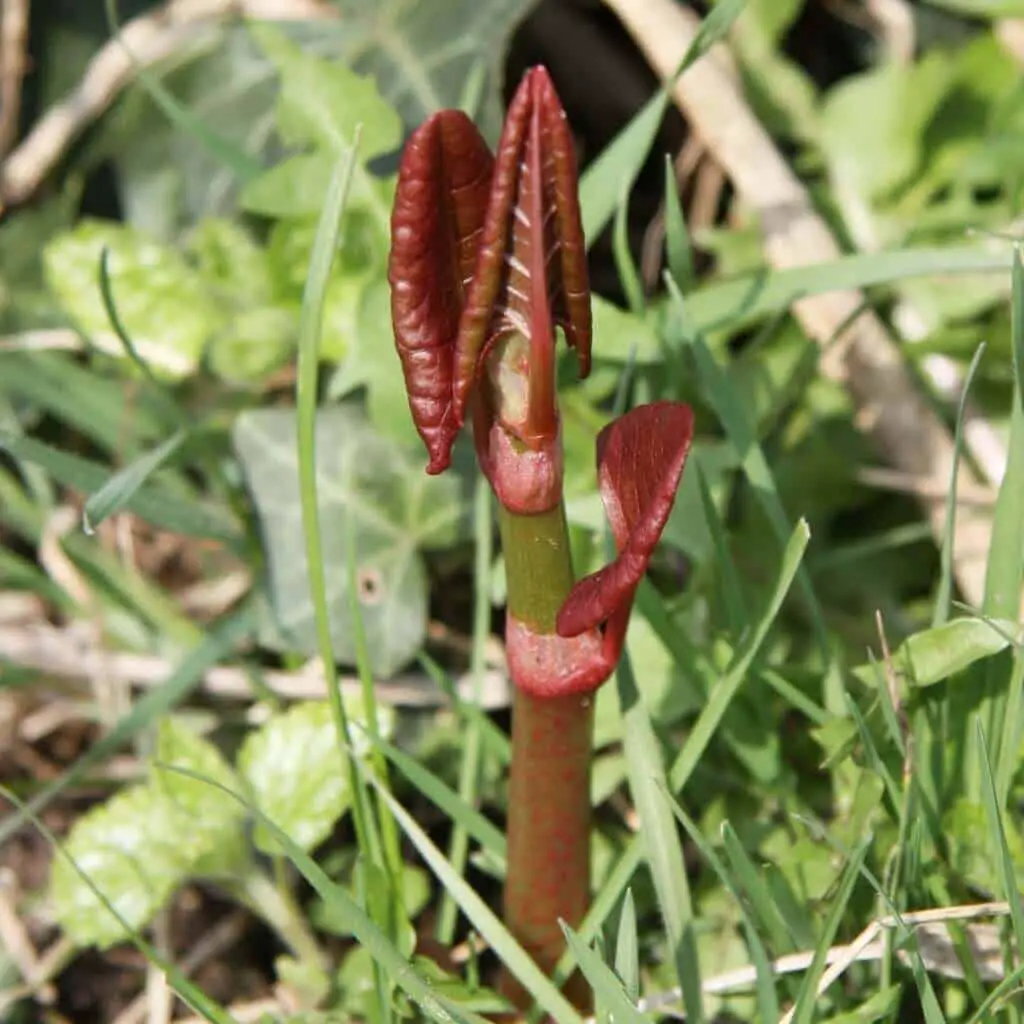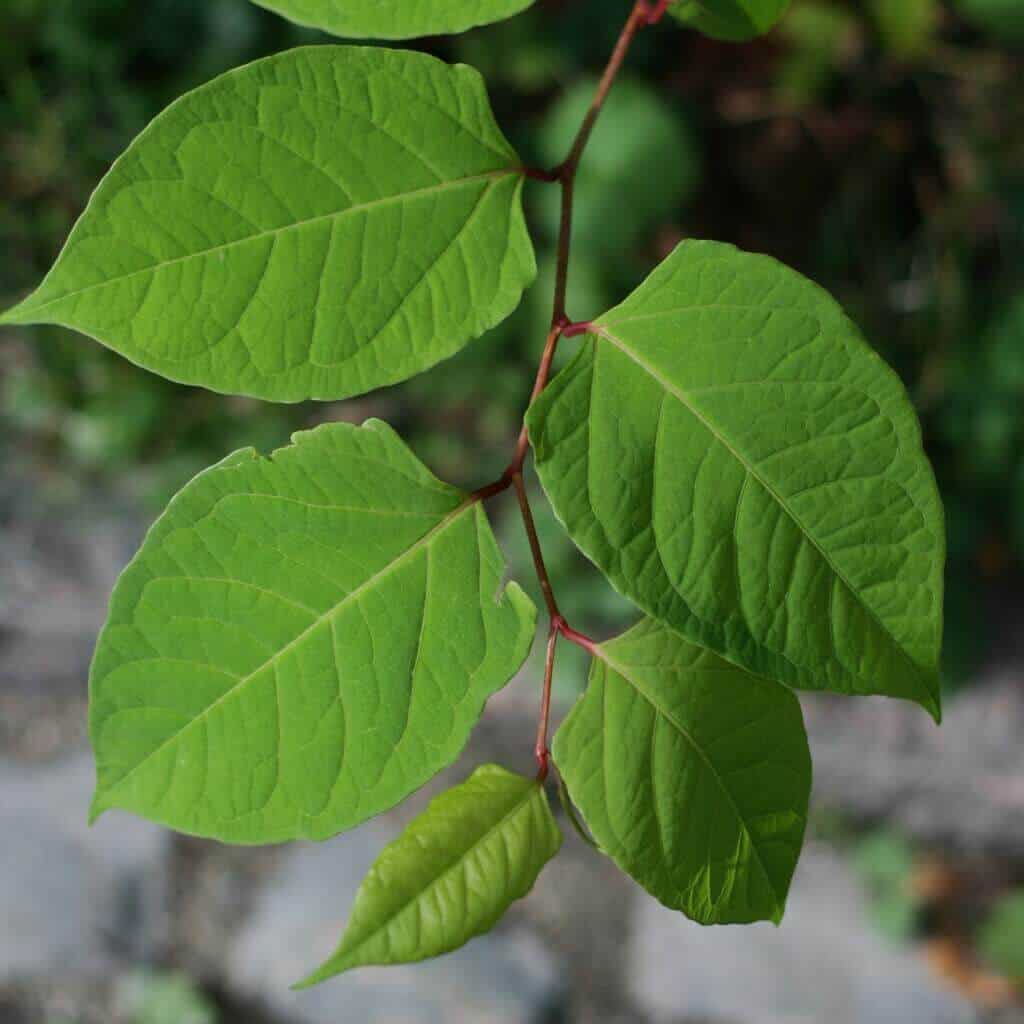Japanese Knotweed Identification
Our comprehensive Japanese Knotweed identification and control guide will show you how this weed changes through the seasons, what does Japanese knotweed look like at each stage and the various methods needed to remove it.
| Quick Facts |
|---|
| Aliases: Asian knotweed, fleece flower, Himalayan fleece vine, billyweed, monkey weed, monkey fungus, elephant ears, pea shooters, donkey rhubarb, American bamboo, and Mexican bamboo |
| Latin Name: Reynoutria japonica (syn. Fallopia japonica, Polygonum cuspidatum) |
| Family: Polygonaceae |
| Plant Type: Perrenial Broad-leaved Weed |
| Preferred habitats: dominates along road verges, river banks, woodlands, grasslands, railway land, waste ground or heavily disturbed ground are particularly vulnerable to infestations. |
The history of Japanese knotweed
Japanese knotweed is indigenous to Japan and neighbouring Southeast Asian nations such as Korea and China, where it coexists alongside a number of closely related species. Many additional species, including Japanese knotweed, were brought to the UK by Victorian plant hunters who returned with exciting specimens for botanic gardens and commercial sale.
Knotweed immediately became known for its uncontrollable growth rate. It wasn’t commonly planted in the United Kingdom until the early 1900s.
The several varieties of Japanese knotweed
Japanese knotweed is divided into various species (Fallopia japonica). Among the most common are:
- Fallopia japonica var. japonica: The most common form of Japanese Knotweed, notable for its aggressive growth and rapid dispersion. Its natural range includes Japan, Taiwan, and parts of China.
- Fallopia japonica var. compacta: Similar to the species above, but with fewer leaves and a more compact growth habit. It is also less aggressive and grows at a slower rate.
- Fallopia japonica var. vegetative is a sterile Japanese knotweed that does not generate seeds. It spreads via vegetative reproduction, which means it spreads via the creation of rhizomes (underground stems) or the roots of stem cuttings.
- Fallopia japonica var. densiflora: This Japanese variation has smaller leaves and a more upright growth habit than the others.
- Fallopia japonica var. megasperma: This is a rare Chinese-native variant of Japanese Knotweed. It has bigger leaves than the other types and a more spreading growth style.
- Fallopia japonica var. taiwanensis: This is a rare Taiwanese variant of Japanese Knotweed. It has smaller leaves and grows more compactly than the other types.
- Fallopia japonica var. albo-lineata has white stripes on its leaves and is less aggressive than the species var. japonica. It is also less frequent and is found mostly in the United States.
What does Japanese knotweed look like?
Japanese knotweed is a tough-to-recognise invasive plant. Japanese knotweed spreads quickly, pushing out native plants and wreaking havoc on infrastructure.
The plant is most usually seen along roadside ditches and other disturbed areas.
Japanese knotweed is a perennial plant that can reach a height of 10 feet. Because Japanese knotweed can be fooled with a variety of different plants, it is critical to be able to recognise it correctly.
The key properties of the Japanese knotweed plant are mentioned below.
Quick Identification Guide
| Origin | Japanese knotweed is native to Japan and nearby Southeast Asian countries such as Korea and China, where it is closely related to several other species. Japanese knotweed, like many other species, was introduced to the UK by Victorian plant hunters who brought back interesting specimens for botanic gardens and commercial sales. However, it was quickly realised that knotweed could quickly outgrow control. It was not widely planted in the UK until the early 1900s. |
| Leaves | Japanese knotweed leaves are quite large, measuring approximately 15cm long by 10cm wide and are light green in colour. They have smooth edges and a flat base, forming a shield shape, though hybrids have lobes at the base, giving them a heart-shaped appearance. In contrast to several similar-looking plants with leaves arranged opposite each other, leaves are arranged alternately along the stems. |
| Flowers | Japanese knotweed has creamy white flowers that appear on panicles made up of dense clusters of small flowers on thin spikes around 10cm long. Individual knotweed flowers on each spike are about 0.5cm wide. The small creamy white flowers appear in late summer and early autumn. Bees frequently congregate around panicles because they provide a valuable source of late-season pollen. |
| Stems | Knotweed stems can grow to be 3m tall on mature plants. They appear as clumps of seemingly discrete stems emerging from ‘crowns’ where Japanese knotweed roots (rhizomes) poke up above ground. The stem base can be quite thick, measuring around 5cm in diameter, and is light green with purple speckles. The rings, or nodes, that form around the stems resemble bamboo canes, but knotweed has hollow stems that are relatively easy to snap. The leafless knotweed stems die back in the winter, and the Japanese knotweed canes become brittle, red-brown, or straw-coloured. |
| Height | If allowed to spread, mature knotweed stands can reach heights of over 3m and cover vast areas covering out other native plants. Growing at an exponential rate of between 10 to 20cm per day. |
| Roots | Japanese knotweed grows in the form of a perennial network of underground shoots known as rhizomes. Thin roots grow from these, supplying water and nutrients to the rhizomes, where starchy energy is stored in the fleshy orange and fibrous tissue. The crowns can be quite large, often measuring around 40cm in diameter, with thick (often 3cm in diameter) rhizomes growing from them in all directions. It is commonly stated that rhizomes can penetrate 3m into the ground, but this is uncommon; most rhizomes are found less than a metre below ground. |
| Seeds | Almost all Japanese knotweed in the UK is a clone of the first plants introduced in the mid-1800s. They were all female (actually male-sterile). As a result, male plants lack the pollen required to produce viable seeds. Russian vine pollen, on the other hand, can fertilise female Japanese knotweed plants, resulting in hybrid seeds. Fortunately, this rarely results in new plants. The hybrid seeds, known as achenes, are black and very small, measuring about 2mm in diameter. They resemble apple pips cut in half, as well as tiny buckwheat achenes, to which they are related. |
How to Identify Japanese Knotweed
Japanese knotweed leaves
Japanese knotweed leaves are shovel-shaped (some people think they look heart-shaped) with a point at the tip and staggered on the stem (one stem per node), creating a zig-zag stem growth pattern. They’re a luscious green colour and grow up to 200mm long per day during summer. See the images below for easy identification of the Japanese knotweed leaf.
They form a shield shape with smooth edges and a flat base, while hybrids have lobes at the base that make them appear more heart-shaped. Unlike a number of similar-looking plants with leaves oriented opposite each other, the leaves of this plant are arranged alternately along the stems.
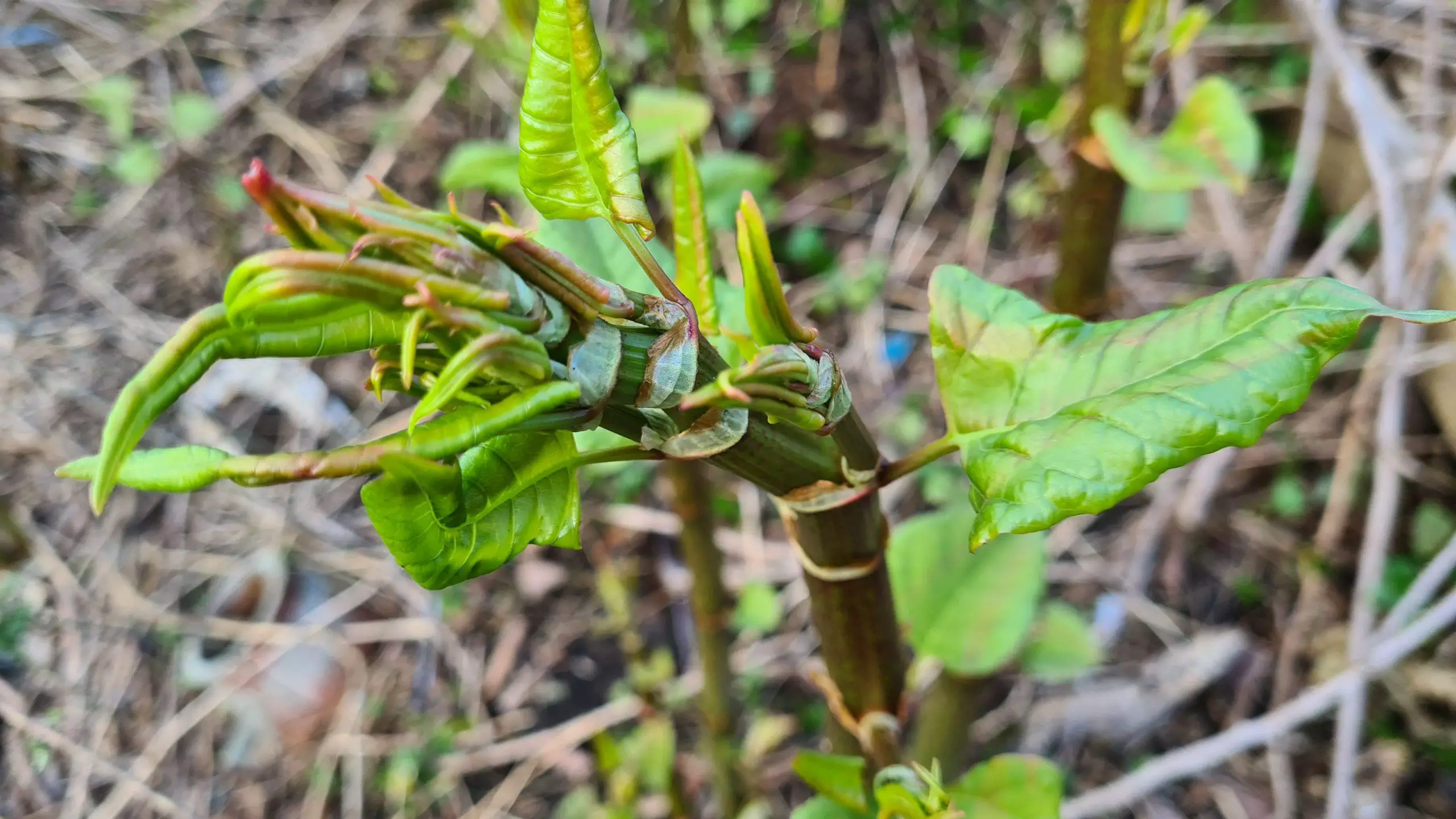
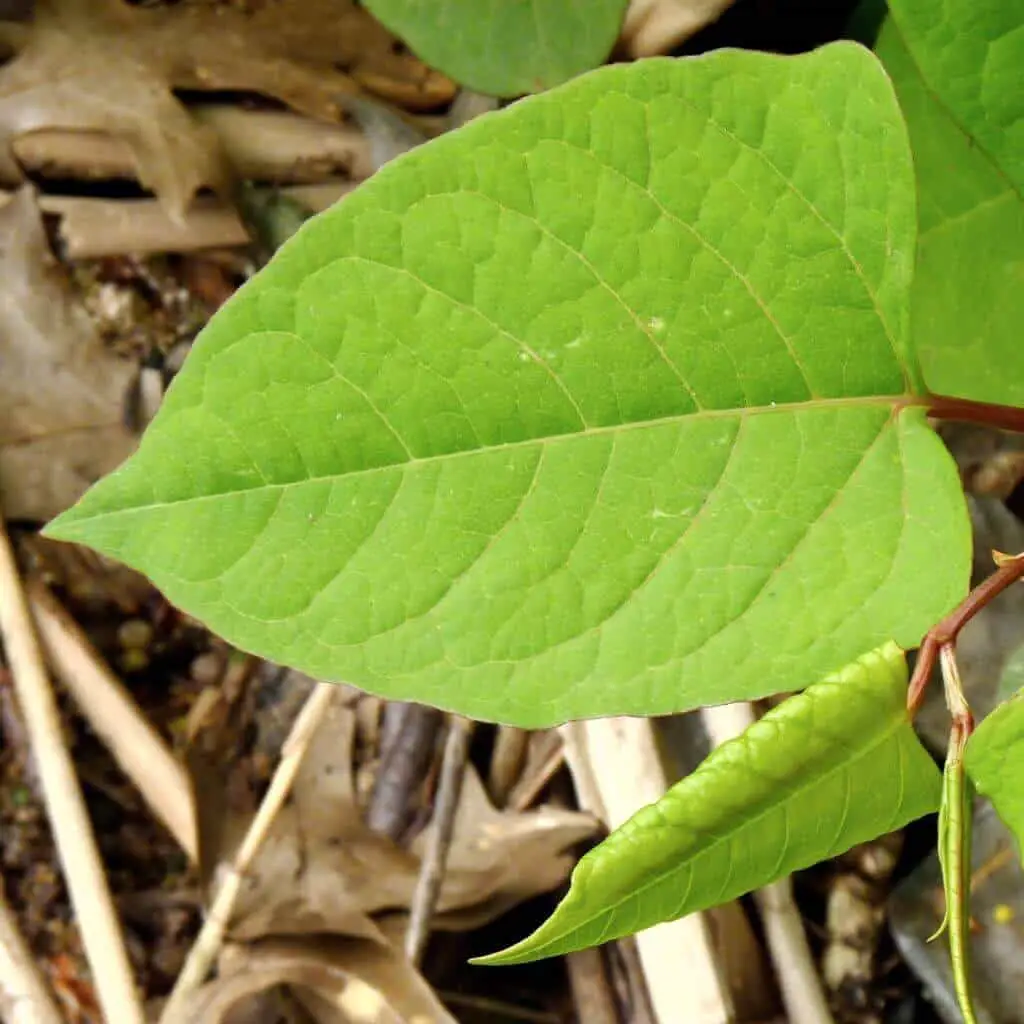
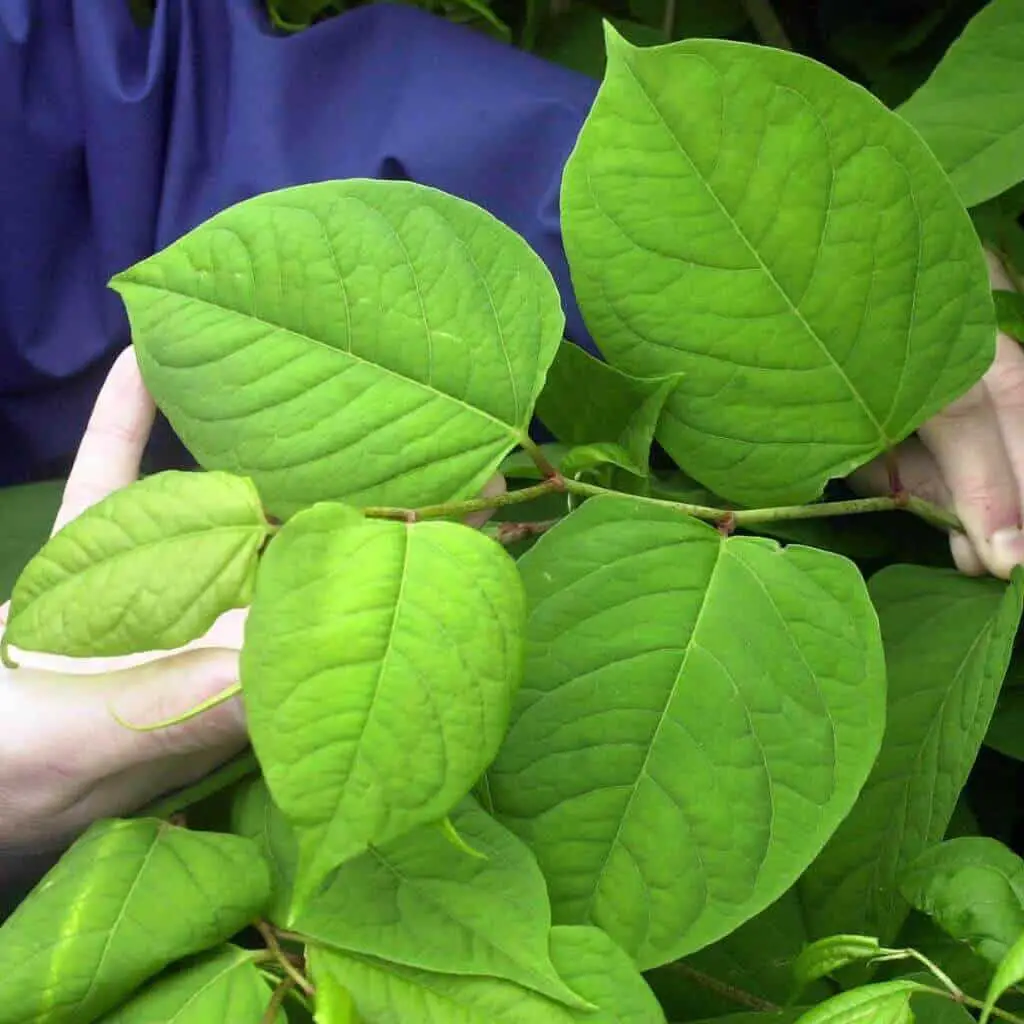
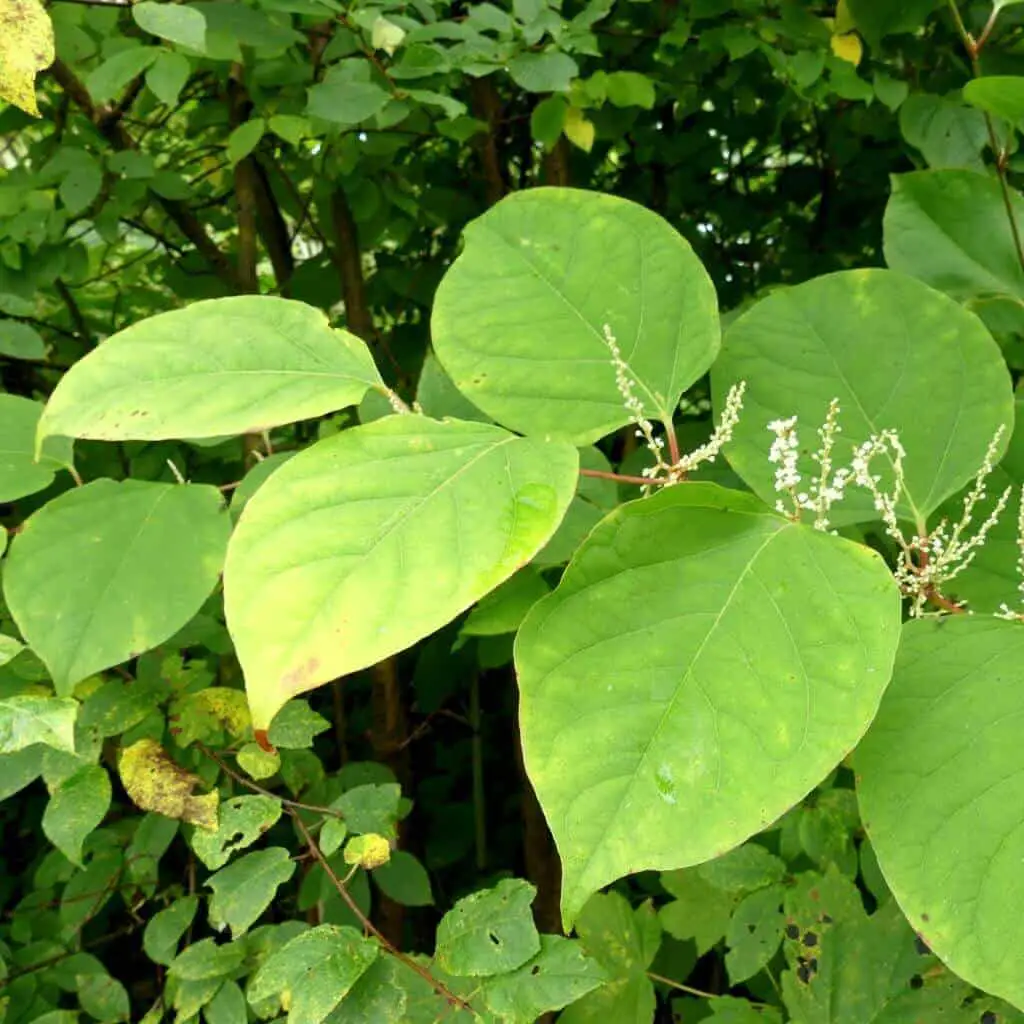
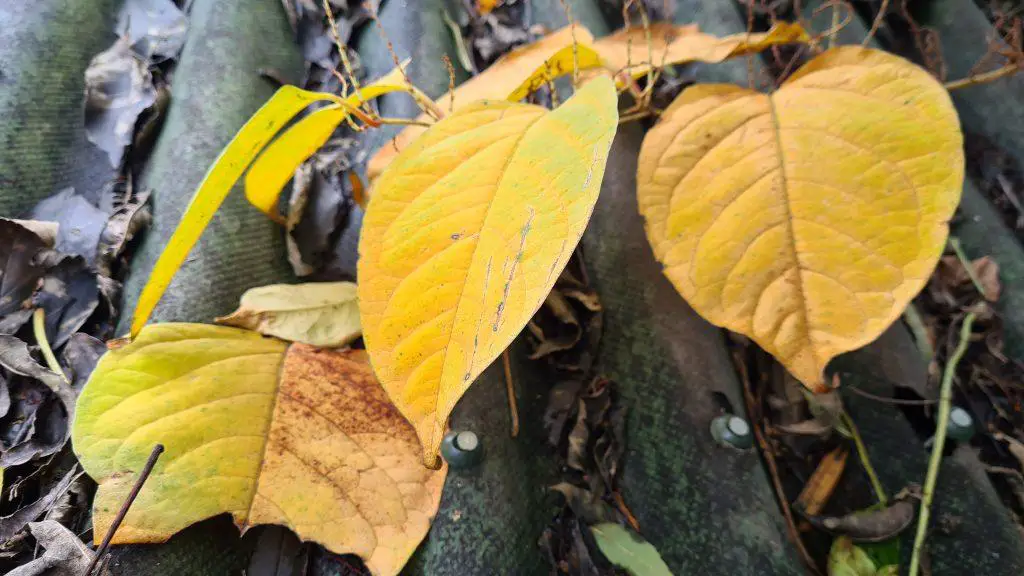
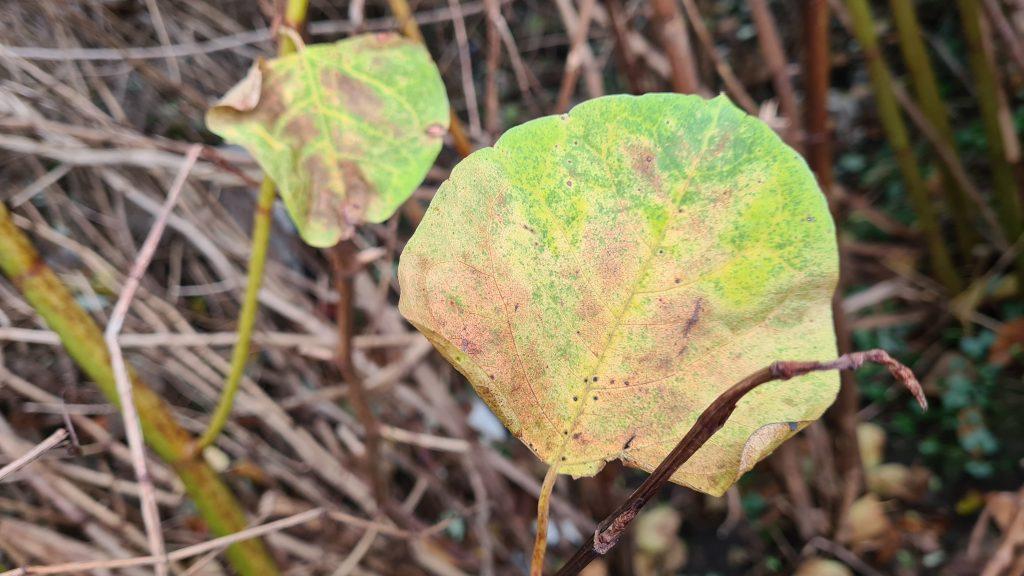
Japanese knotweed stems
Japanese knotweed stems grow to 2-3 metres tall. They’re similar to bamboo with nodes and purple speckles and the leaves shoot out from the nodes in a zig-zag pattern. The inside of the stem is hollow.
They appear as bunches of seemingly distinct stems emerging from ‘crowns’ where the roots (rhizomes) protrude above the ground. The stems’ bases are bright green with purple speckles and can be fairly thick, measuring around 5cm in diameter.
Knotweed stems have rings, or nodes, surrounding them that give them the appearance of bamboo. However, unlike bamboo, knotweed stems are relatively easy to snap, revealing a complicated hollow interior. The leafless stems die back in the winter, leaving brittle red-brown or straw-coloured canes.
At the mature stage, the stems are hollow and not woody and can be snapped easily to show their hollowness. However, in the winter the stems become brittle, as can be seen from the images below.
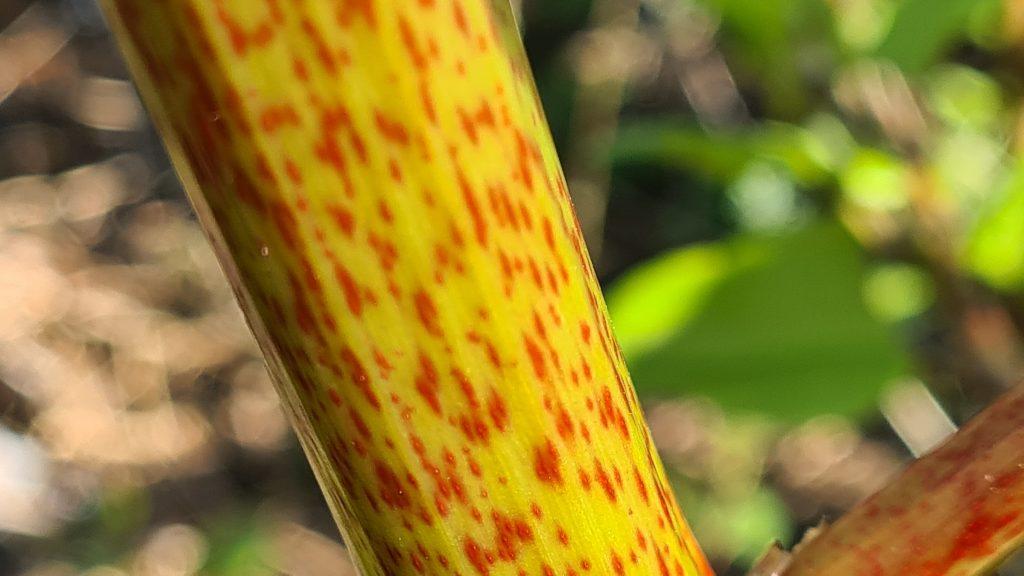
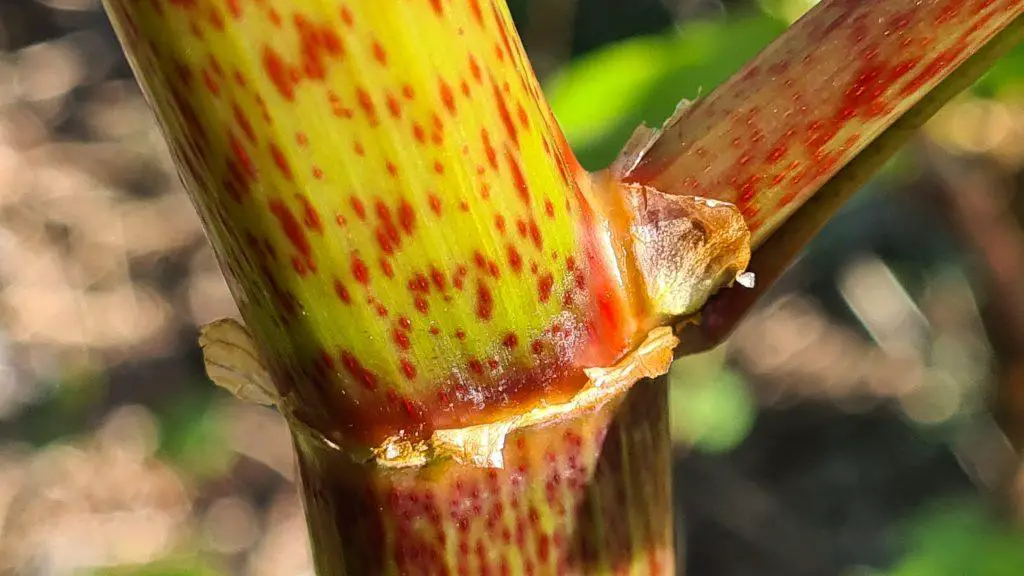
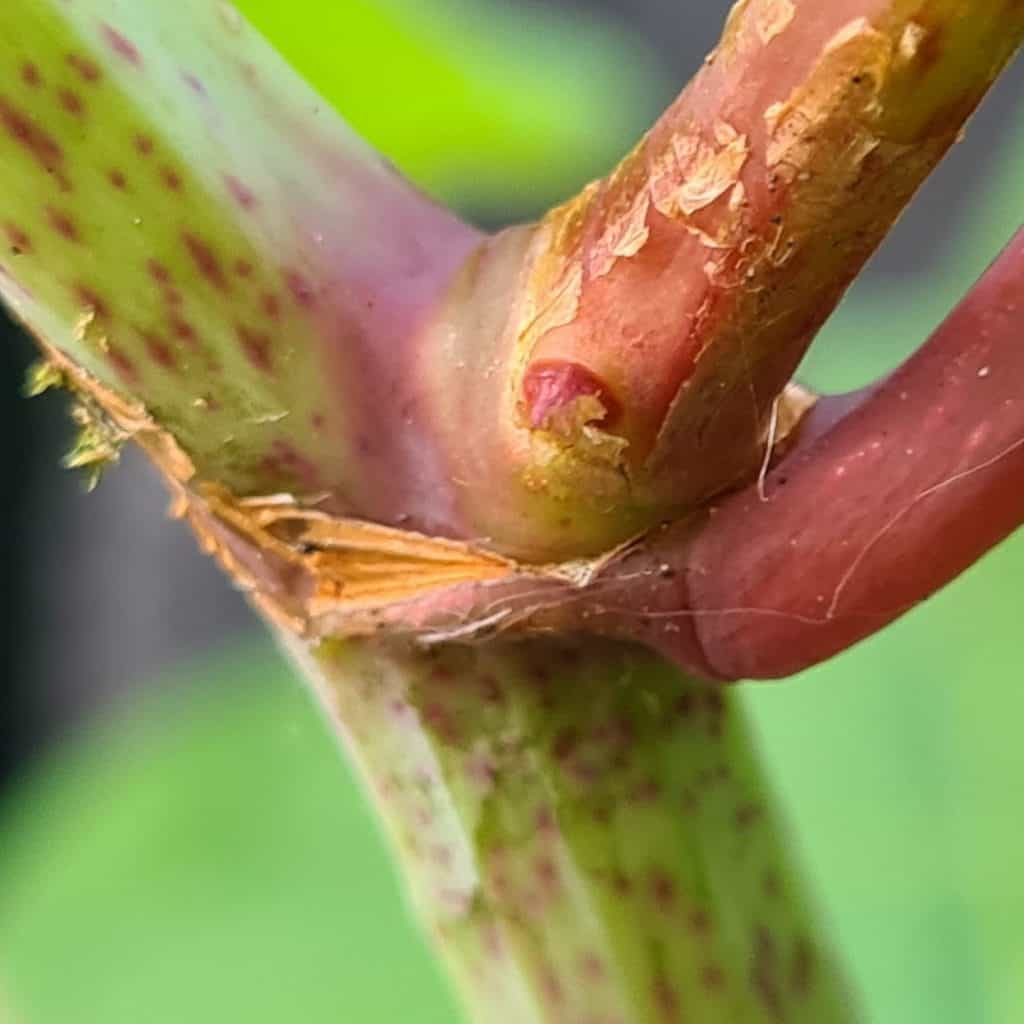
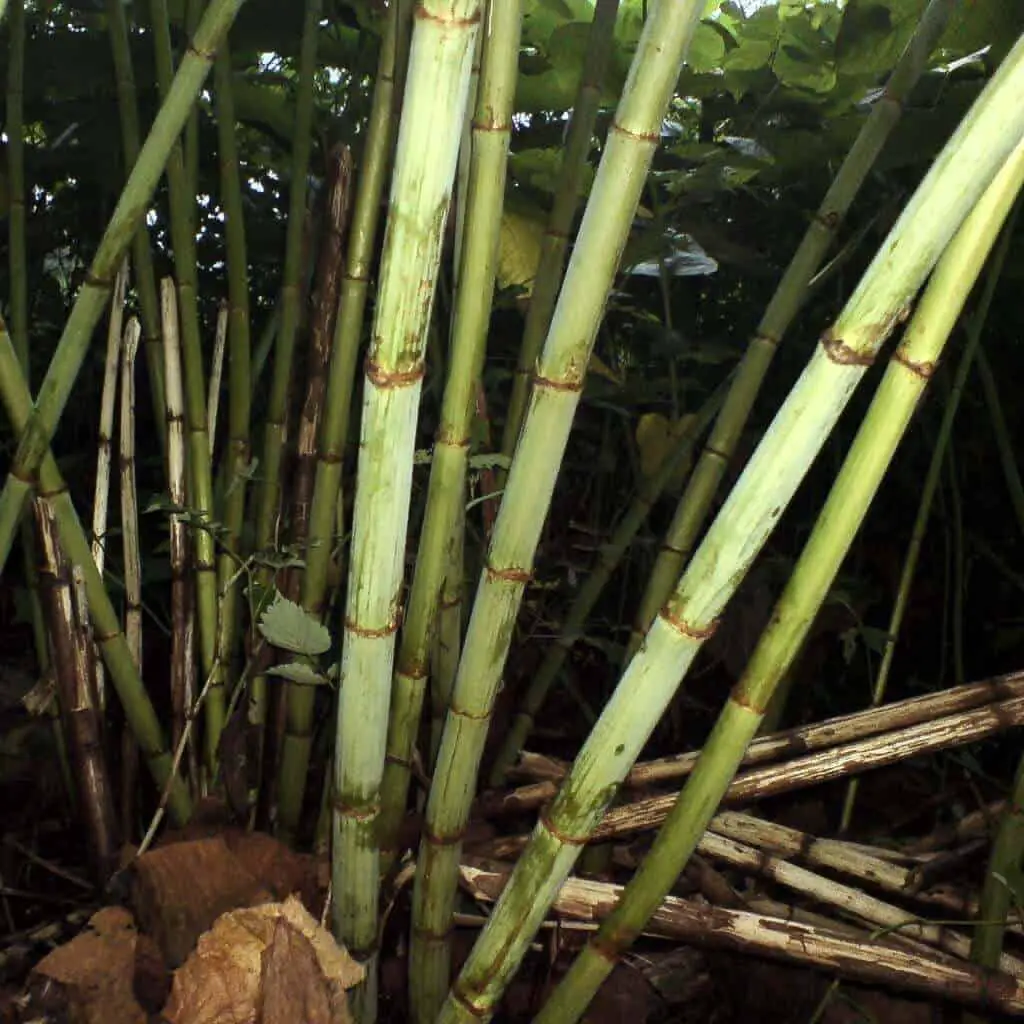


Japanese knotweed flowers
Elongated clusters of milky white flowers may appear in late August or early September. Blooms appear on panicles, which are made up of dense clusters of small flowers on slender, 10 cm long spikes. Individual flowers on each spike are around 0.5cm across.
The leaves will still be visible, and together with the flowers, they will form dense foliage. To recognise knotweed blossoms, look at the photographs below.
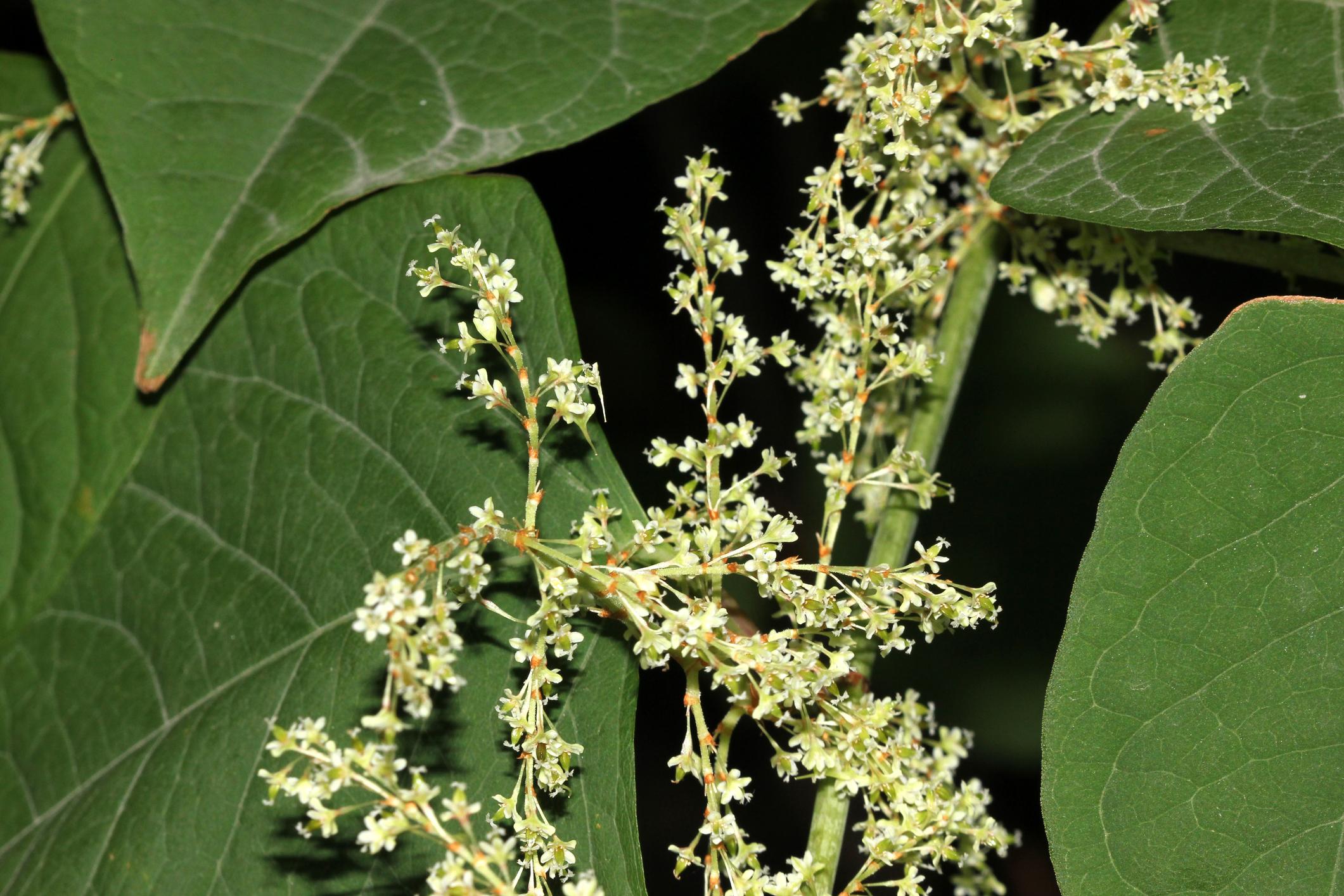
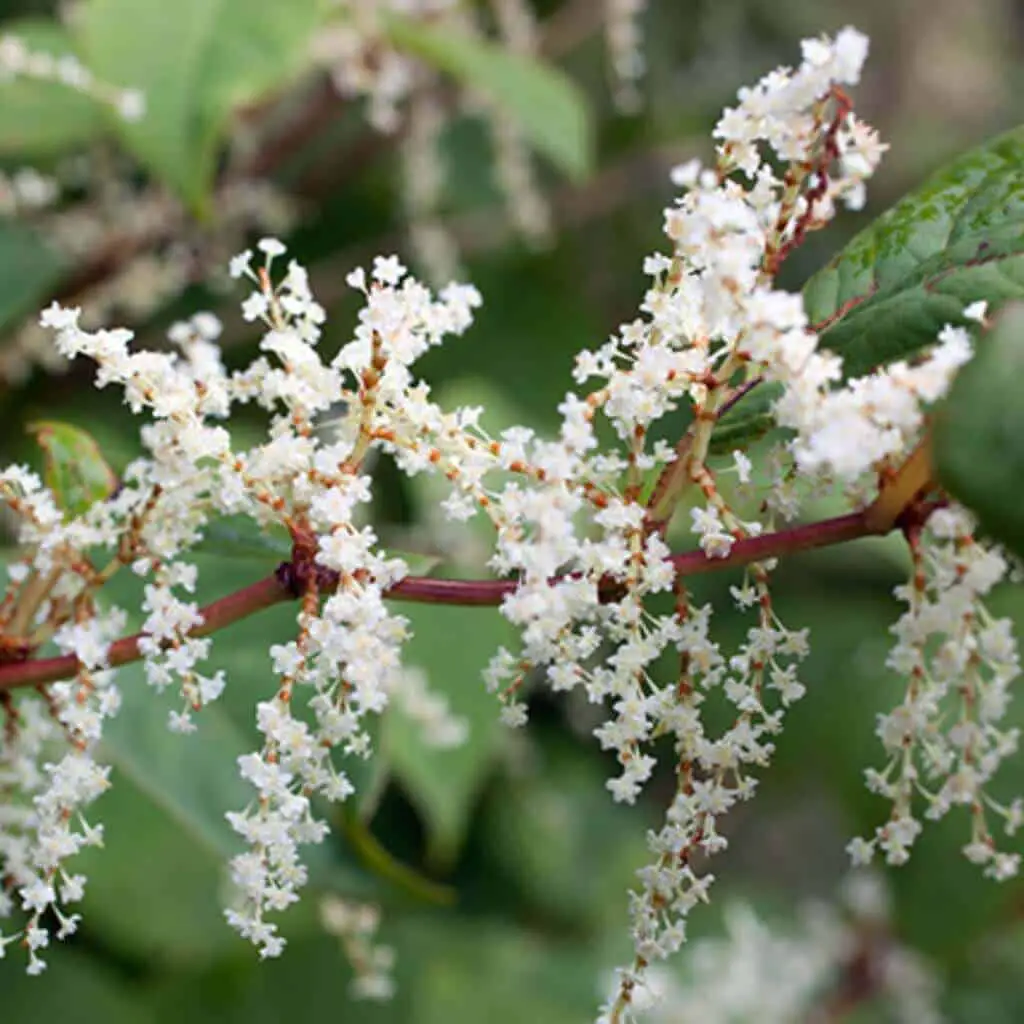
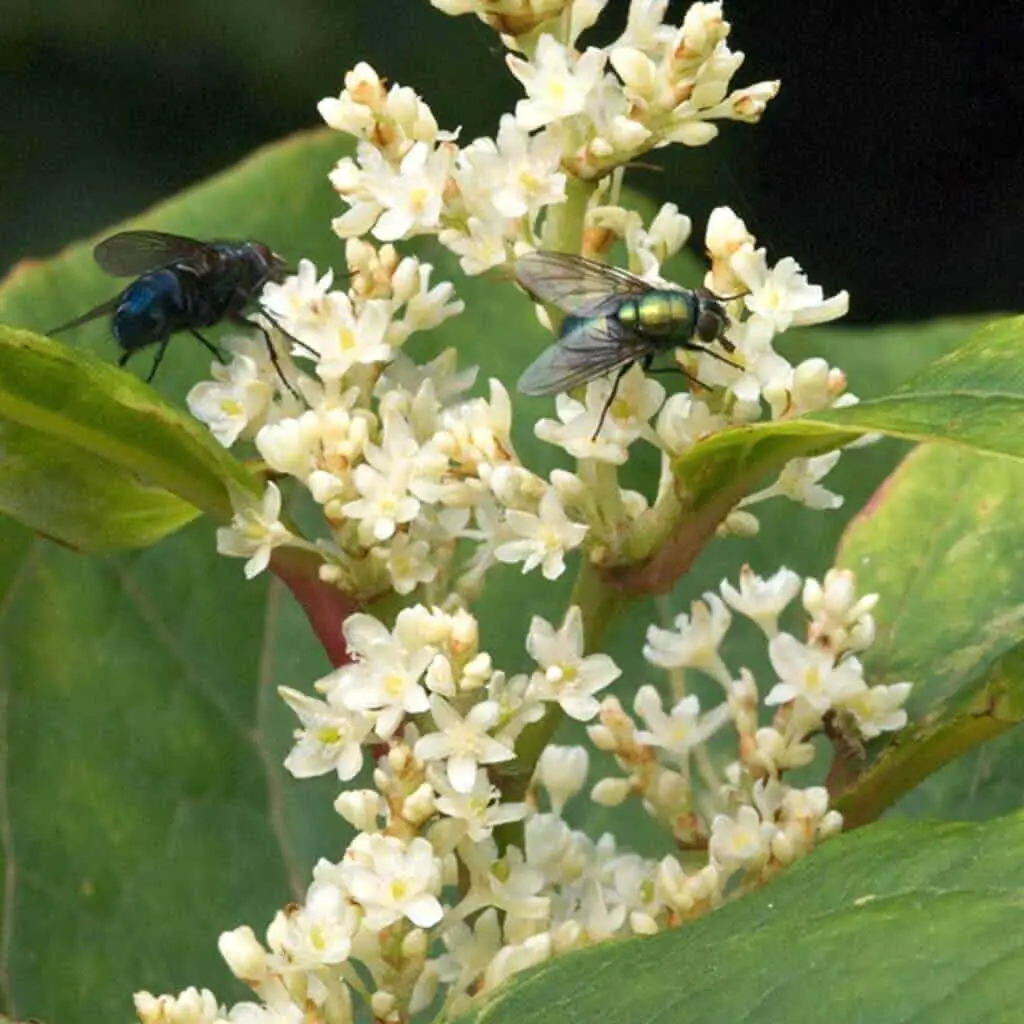
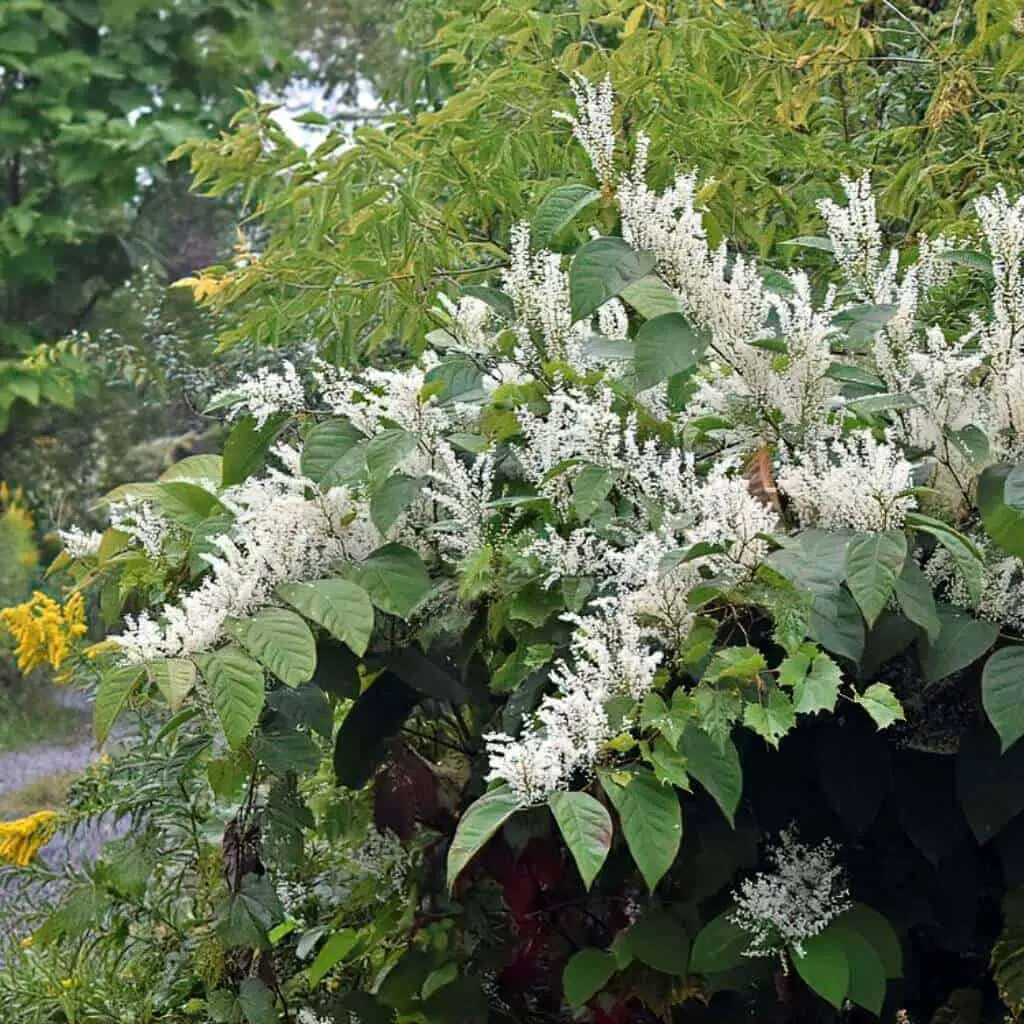
Japanese knotweed seeds
Almost all Japanese knotweed in the UK is a clone of the initial plants introduced to the country in the mid-nineteenth century. They were all female (actually male-sterile). As a result, no pollen from male plants is available to create viable seeds.
Russian vine pollen, on the other hand, can fertilise female knotweed plants, resulting in hybrid seeds. Fortunately, this almost never results in the emergence of new plants.
The hybrid seeds, known as achenes, are black and have a diameter of around 2mm. They resemble apple pips when split in half, or tiny buckwheat achenes, with which they are closely related.
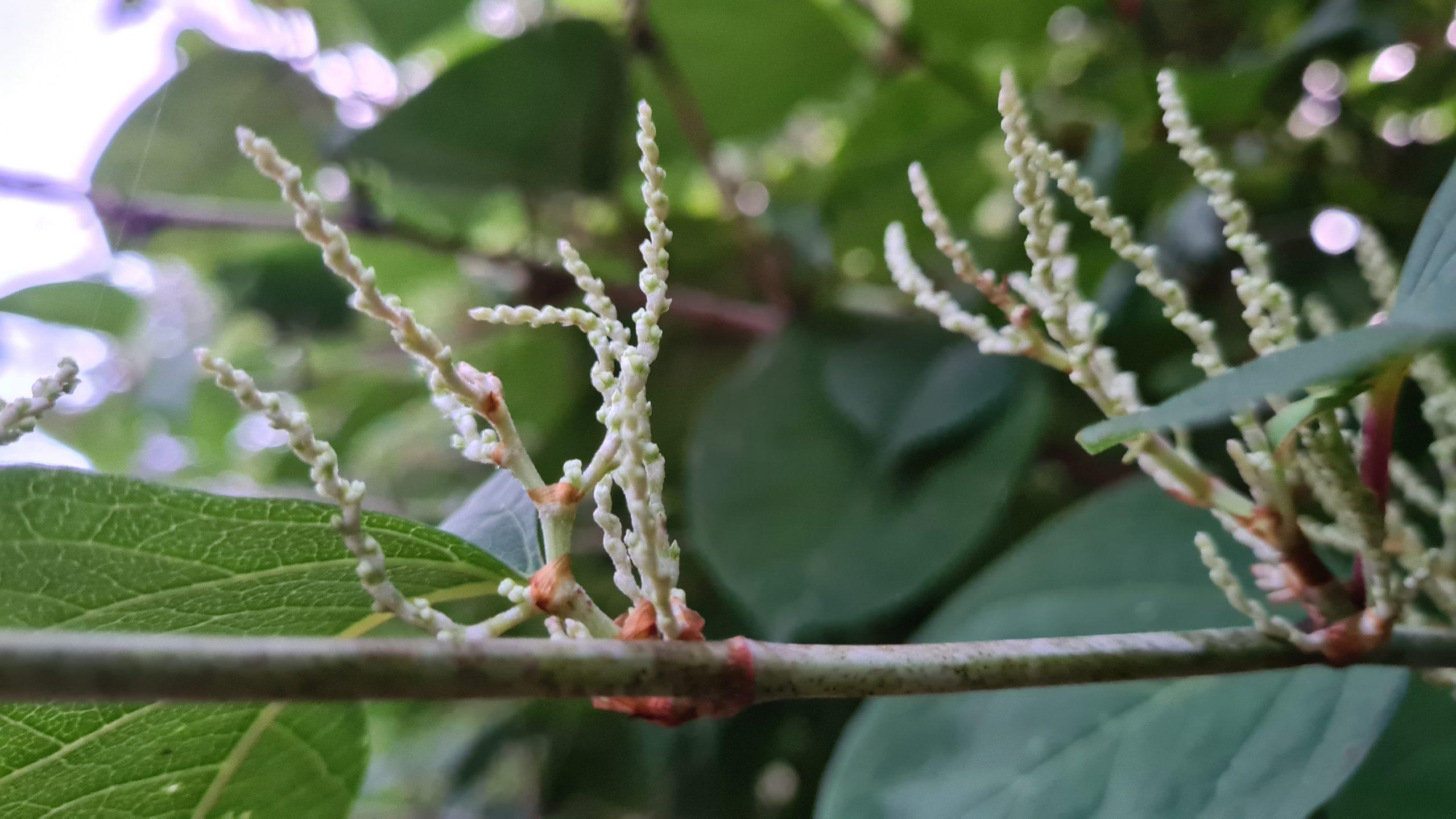
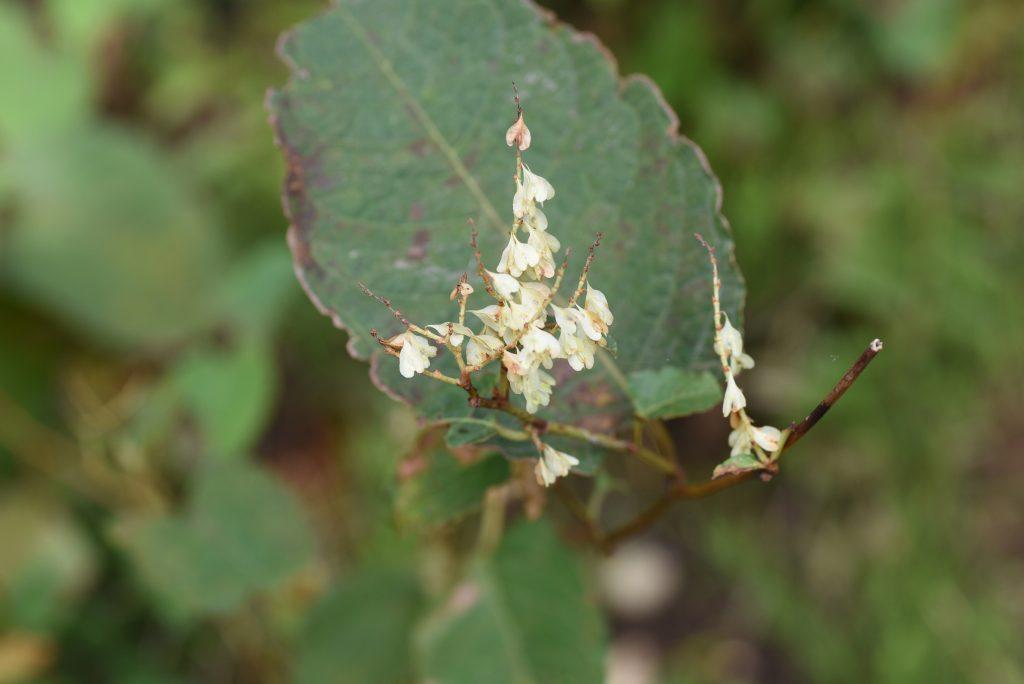
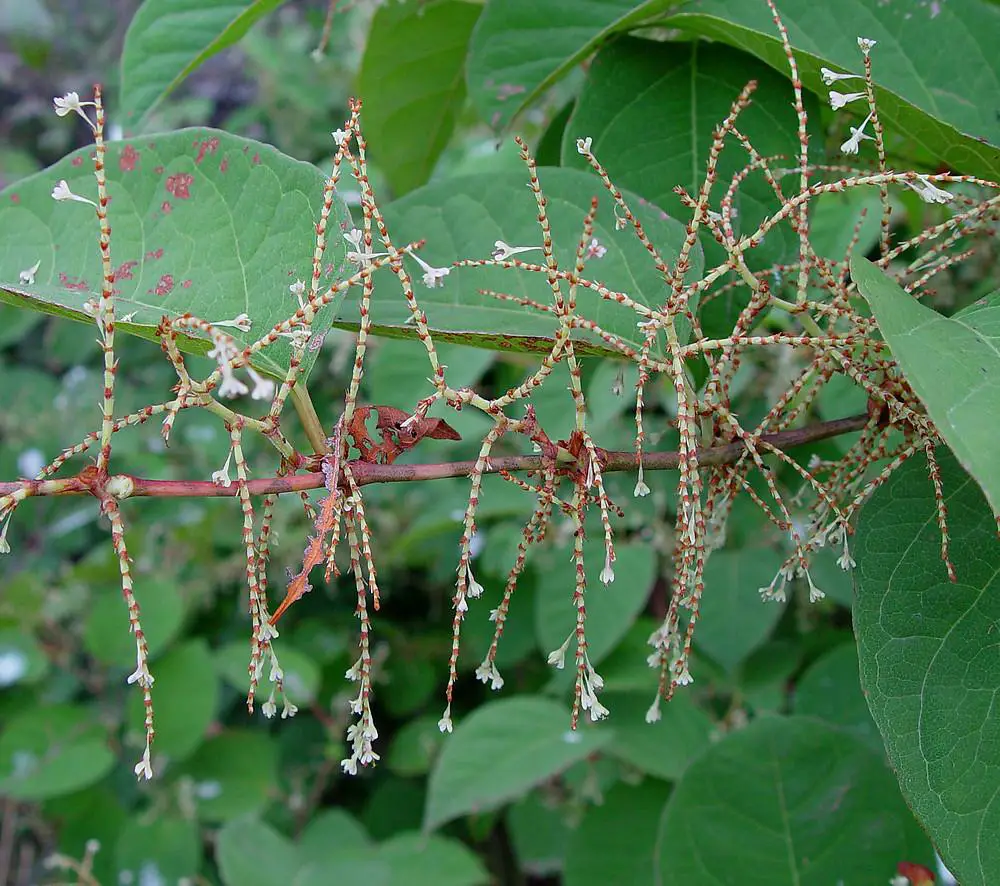
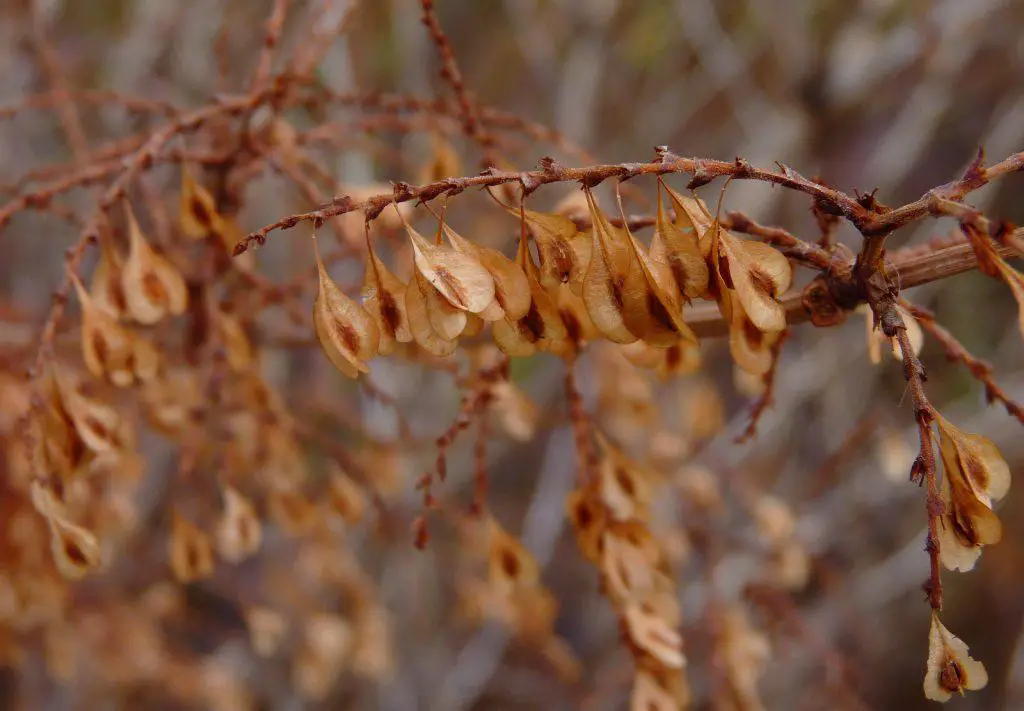
Japanese knotweed roots
Japanese knotweed is a permanent network of underground shoots called rhizomes, similar to fungi, which live in the soil as a network of threads (hyphae) until exposed to their presence to create spores from the fruiting bodies that appear like mushrooms and toadstools.
Thin roots emerge from these, delivering water and nutrients to the rhizomes, which store starchy energy in the fleshy orange and fibrous tissue. The crowns can be quite big, measuring up to 40cm in diameter, with thick (typically 3cm in diameter) rhizomes extending outwards.
Rhizomes are said to be able to penetrate 3 metres into the ground, however, this is extremely rare; the majority of rhizomes are discovered less than a metre underground.
Japanese knotweed rhizomes are the underground part of the weed and are considered to be underground stems. If it’s fresh, it will snap easily like snapping a carrot. The outside is dark brown and the inside is orange/yellow in colour.
The Japanese knotweed rhizome system can grow to depths of 2 metres and can extend up to 7 metres horizontally from the plant. It’s the knotweed rhizome that spreads the plant by vegetative means. As few as 0.7g viable rhizomes could give rise to a new plant. See the images below to assist in identifying knotweed rhizomes.
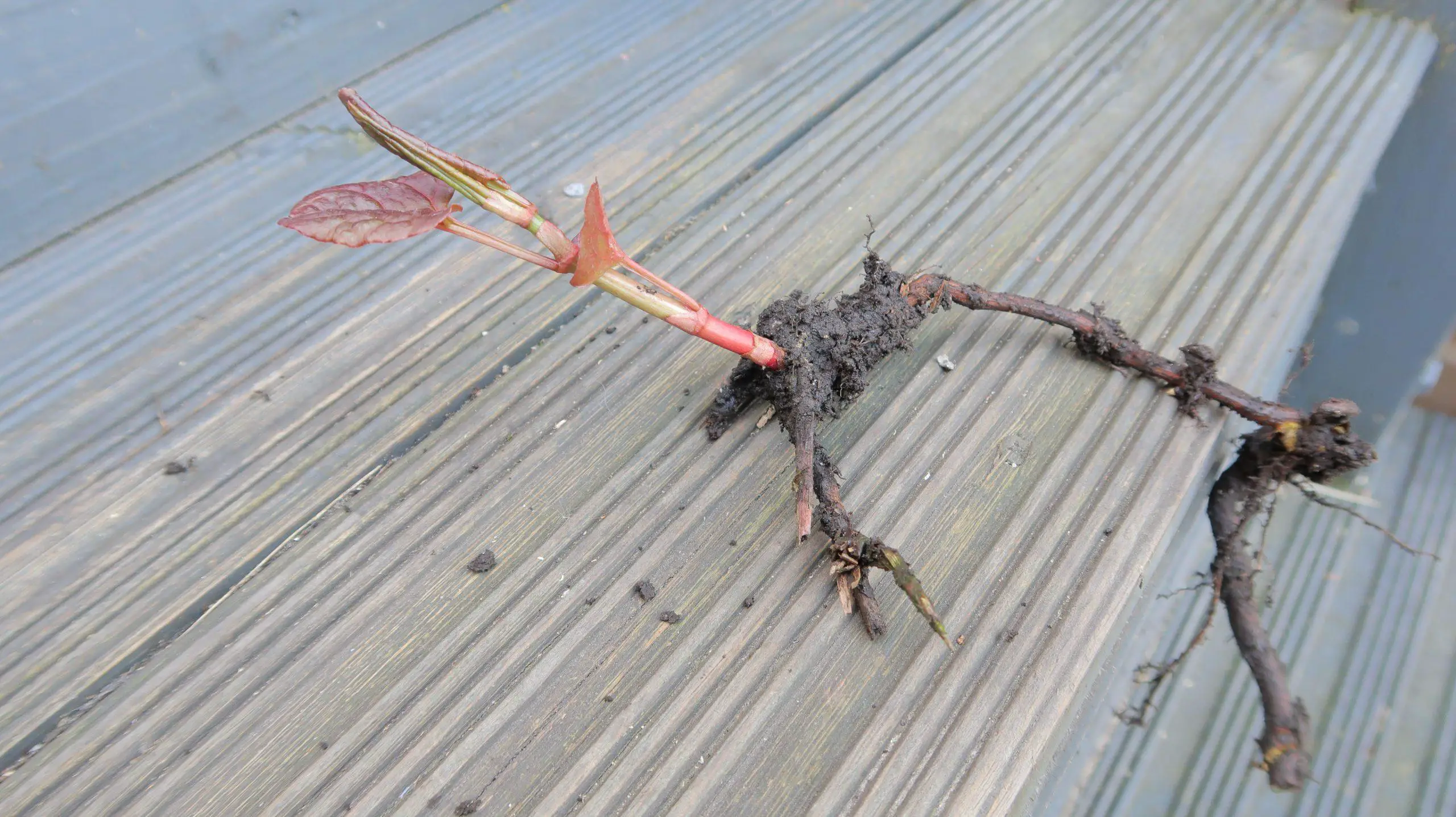
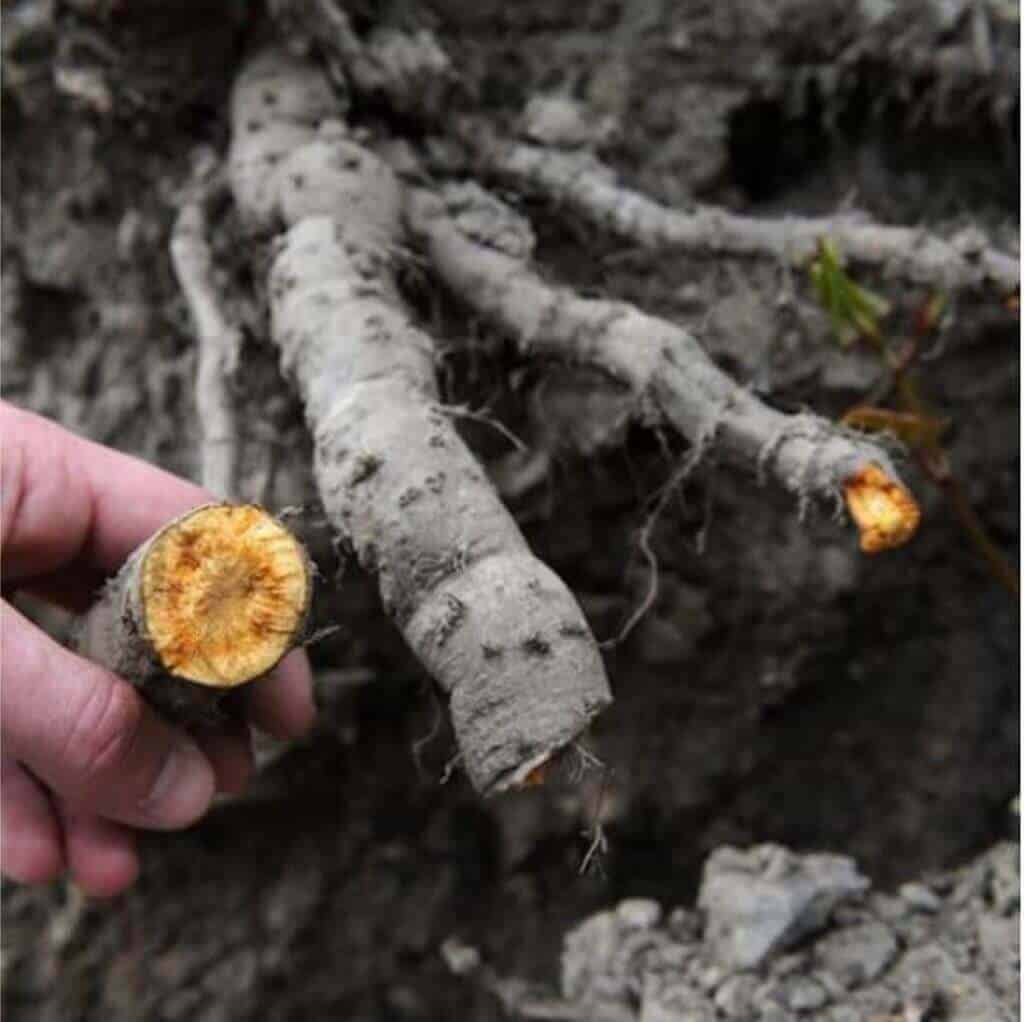
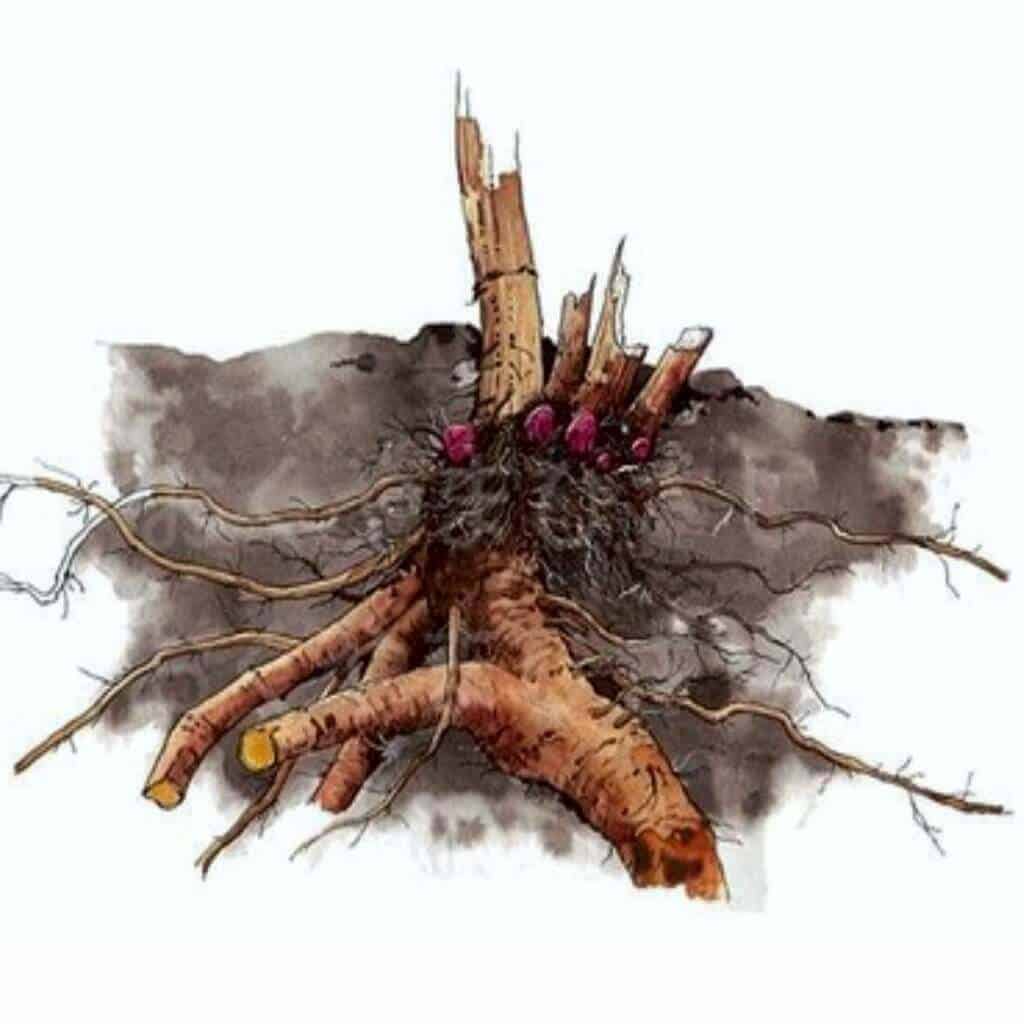
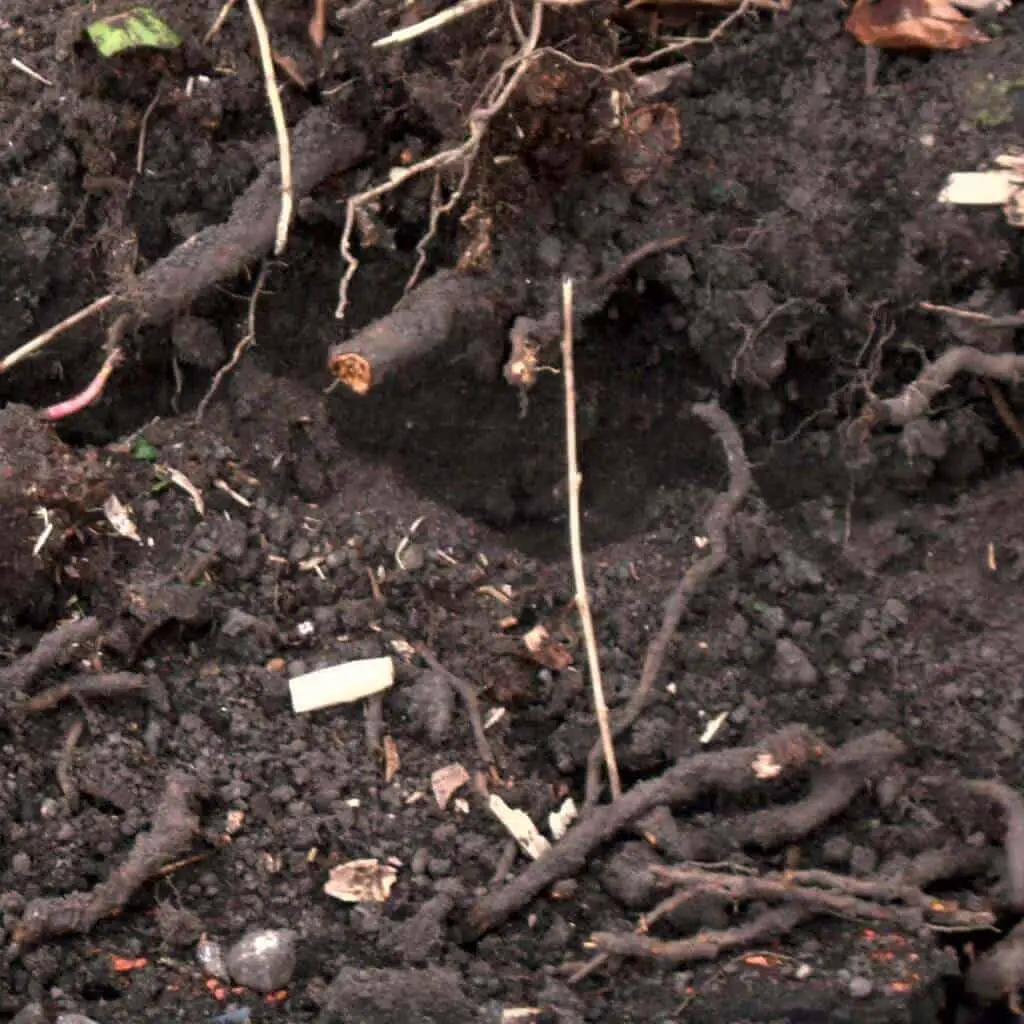
Japanese knotweed is a rhizomatous plant that spreads through the soil. This means it stores energy and spreads through the ground using a fleshy network of underground branches. This is a natural survival strategy that permits plants to live year after year by hedging their bets when growth conditions are bad, such as during excessively dry seasons, so that their energy stores may support them until conditions improve.
In this sense, rhizomes can be compared to a seed bank in the soil, where it is another survival strategy of other plants to create seeds that can lie dormant in the earth during seasons when germination is difficult. Some plants can survive in the ground for many years – even decades – thanks to the rhizome and seed survival methods. Knotweed has unusually vast underground rhizome networks, which often spread a few metres from the crowns.
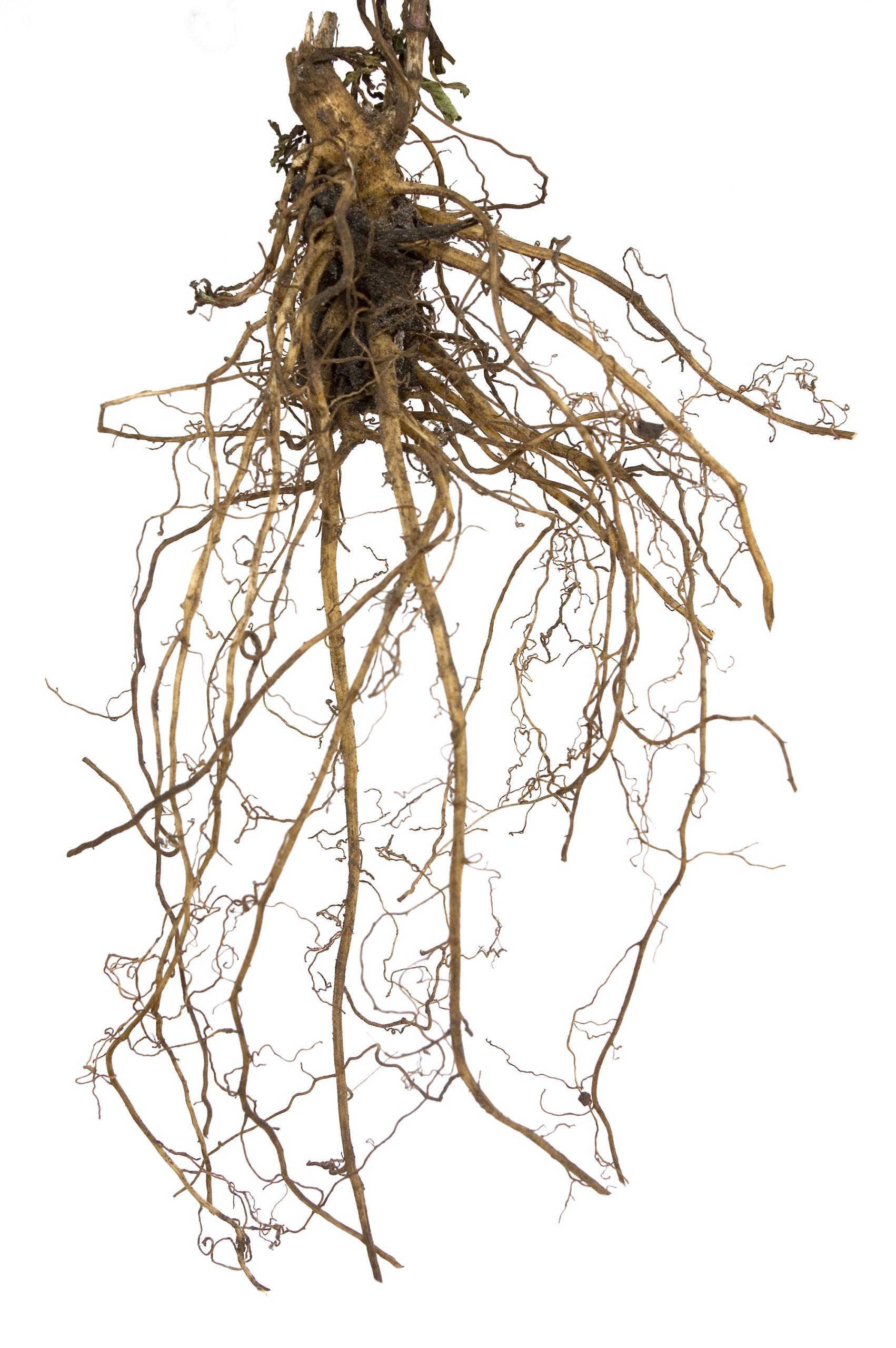
In the right circumstances, the dispersion can be much wider. Knotweed rhizomes are also recognised for their ability to penetrate the earth to depths of a metre or more (3m is often quoted in guidance). In Japan, knotweed spreads via spreading rhizomes, causing crown rings to form after decades of growth.
The older, central crowns begin to die back while above ground the shoots appear on the margin of spreading growth. These ‘ramets’ of stems on the ring’s edge eventually detach from parent growth, giving rise to new ‘daughter’ knotweed populations. This is a frequent mechanism of reproduction and spreads in rhizomatous plants.
Early growth of Japanese knotweed
The appearance of young Japanese knotweed stems varies greatly depending on the maturity of the stand from which they emerge each spring and how control methods may have influenced their growth.
New shoots emerge from thumb-sized buds that are dark red and pink in colour and begin to show themselves in late winter from healthy and mature crowns. The quickly spreading shoots resemble thick asparagus spears until the leaves unfurl, which occurs when the stalks reach roughly 30cm in height.

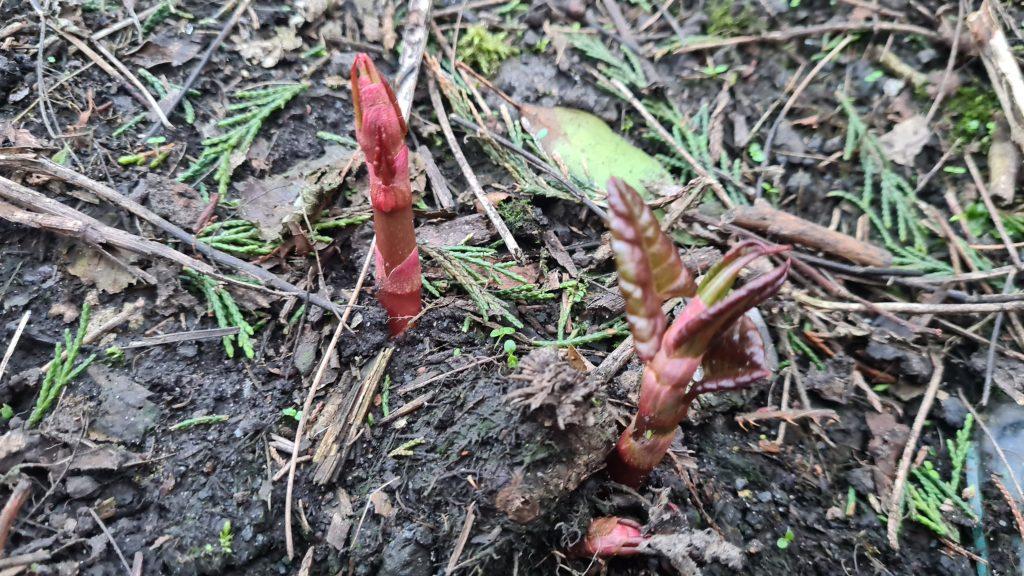
Young Japanese knotweed shoots appear as dark red/purple shoots with tightly curled leaves as they sprout from the ground a few metres from the nearest crowns, seemingly unnoticed. Rhizome buds, which are significantly smaller than crown buds, are responsible for this growth.
If you’ve seen them before, you’ll recognise the little shoots. Many other plants, on the other hand, generate comparable branches (the red colour is due to defensive compounds called anthocyanins), which can be alarming to the unsuspecting. Peony unfurling shoots are one example of a plant that is frequently reported as knotweed in early spring.
New shoots from Japanese knotweed that have been treated with herbicides in the past may seem malformed. When glyphosate is applied, micro-leaves and micro-stems commonly form, resulting in what is known as ‘bonsai’ knotweed. Other herbicides can cause stems and foliage to twist and curl. When crowns are removed by digging, stems that are smaller than typical develop.
Because knotweed has such a wide range of appearances, it’s best to get professional advice. This is especially true if there has been evidence of previous poor treatment, as this can complicate the most effective treatments in the future.
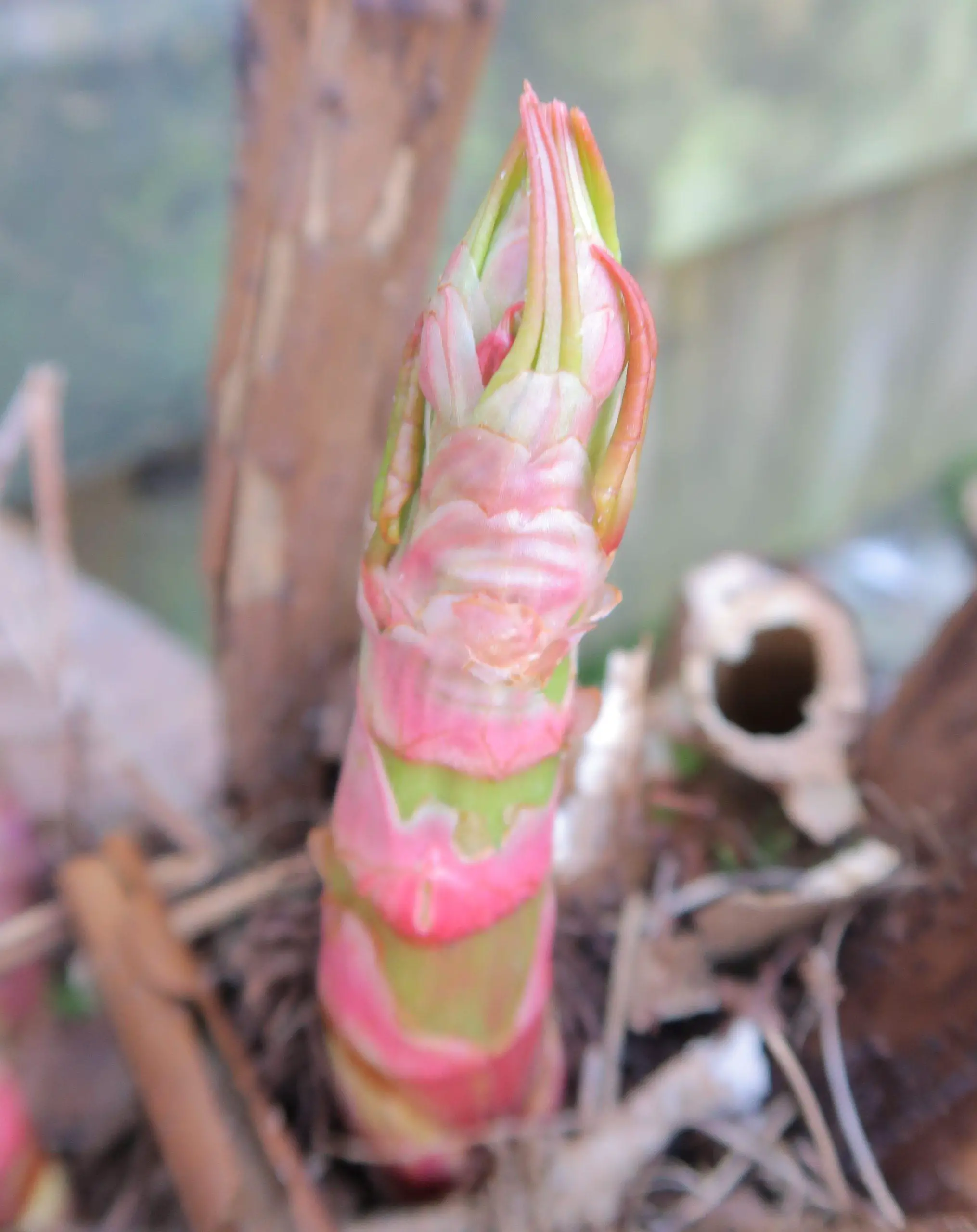
Determine the early signs of Japanese knotweed
When Japanese knotweed threatens their property, most people become concerned. The following are the most often-seen phenomena:
- Small purple shoots appear unexpectedly from the ground
- Clusters of hollow, lifeless stems
- Canes and stems that resemble bamboo
- Leaves shaped like a shield, shovel, or heart
- Extremely rapid growth rates
- Invasive plants from neighbouring properties have taken over
- Plants that grow through built structures cause damage to them
If you are concerned that you may be infected with knotweed, look for the signs and symptoms indicated above. Any of these concerns should be raised with a competent contractor who can offer additional advice and support.
When is the best time to identify Japanese knotweed?
The best time to identify Japanese knotweed is during mid-summer and early autumn. During spring, reddish/purple shoots appear from the ground and fat, asparagus-like ‘spears’ rapidly lengthen from bright pink ‘crown’ buds. These can grow up to 20 cm a day, thus rapidly forming dense stands of bamboo-like stems that develop green heart- or shield-shaped leaves.
By early summer the mature Japanese knotweed stems are hollow with purple speckles and can reach up to 3 metres in height. The leaves alternate along each side of the stem, producing an obvious knotweed zigzag pattern.
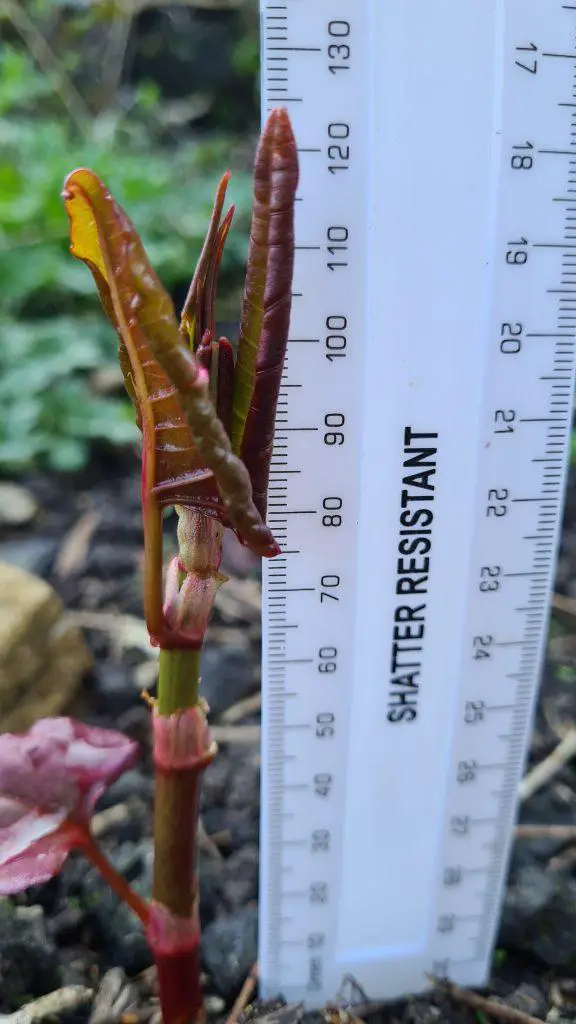
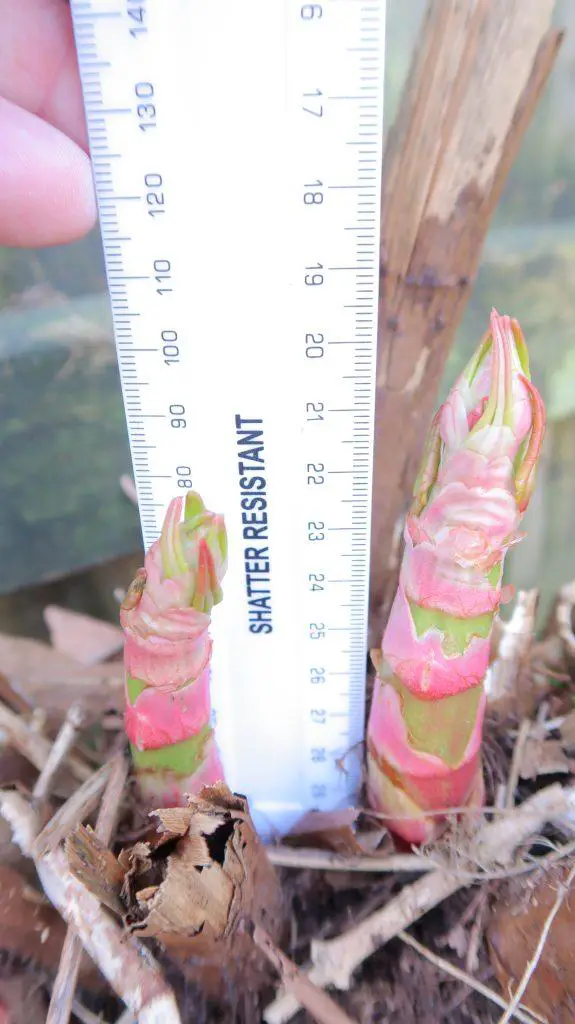
The knotweed flowers that emerge by late summer are creamy-white in colour and appear in lengthy cluster/spike formations. Japanese knotweed spreads mainly from its underground rhizomes/roots which lie dormant, but alive, over the winter months.
The rhizomes can spread several metres outwards from the visible, aboveground stems, to depths of more than a metre. It is therefore very easy to accidentally fragment pieces of rhizome and spread them by disturbing the soil several metres from where the stems appear.
As new growth from seeds is very rare, it is a testament to the plant’s incredible invasiveness that it has spread to most parts of the UK (and many parts of western Europe and North America, for that matter) simply through fragmentation and translocation of rhizomes in contaminated soil.
Japanese Knotweed through the Seasons
Identifying the way this weed changes through the seasons and knowing how to deal with it requires both knowledge and visual clues to help you identify it and tackle it for removal.
below we have itemised the changes to this weed through the four seasons and have catalogued its characteristic changes for your reference.
Japanese knotweed in spring
The fastest Japanese knotweed growth is during the spring. New shoots that emerge are red/purple and can look like asparagus spears. The leaves are normally rolled up and dark green or red in colour. In late spring, canes can reach up to 3 metres (10 feet) high. The pictures below show Japanese knotweed in spring.

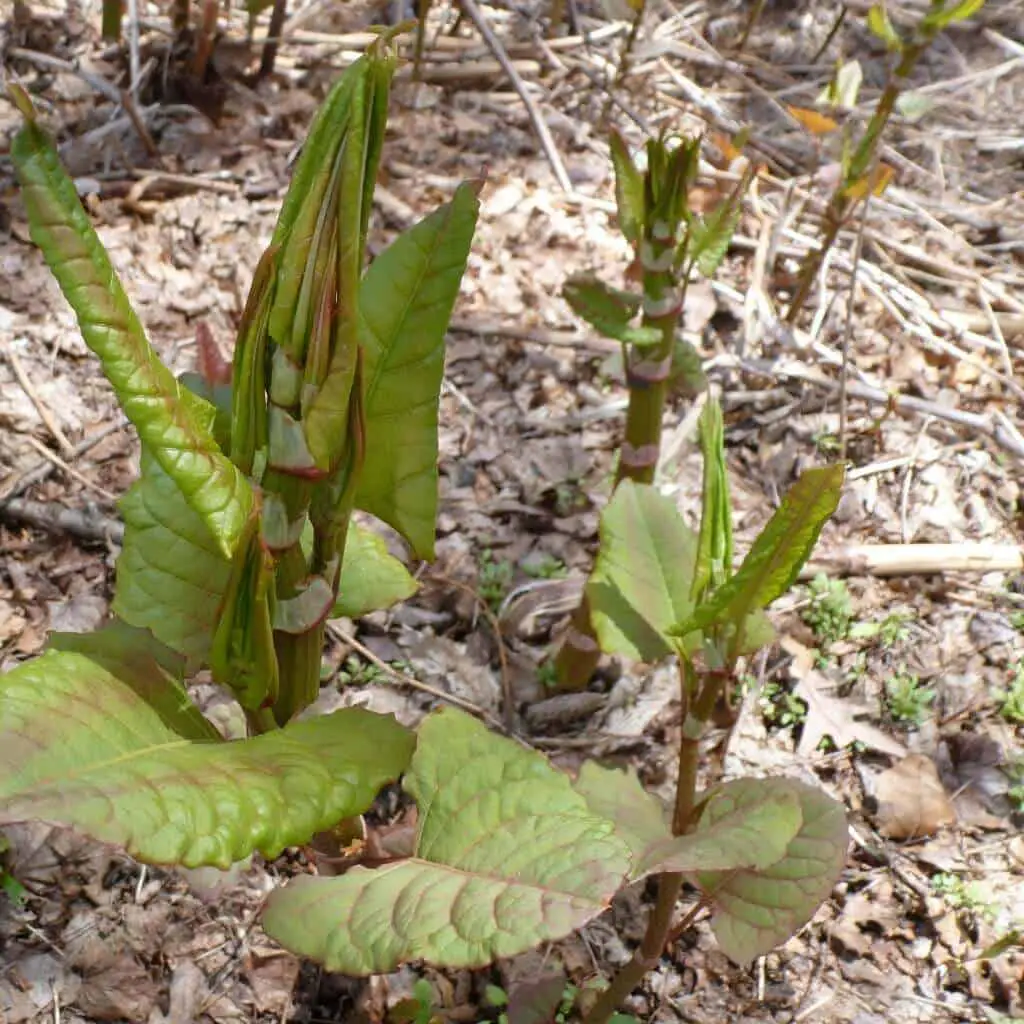
Early spring, around March to April, sees the emergence of new shoots. At this time of year, the rate of growth is astonishingly fast. Within a few weeks, thick, asparagus-like shoots from mature crowns can reach a height of a metre or more.
If you enjoy foraging, this is the best time to gather knotweed stems to eat (Japanese knotweed crumble recipe). The development of little, dark red/purple shoots from rhizome buds can be startling, especially because they appear out of nowhere.
At this time of year, the tightly wrapped leaves and the colour of the shoots make them stand out. The way the leaves unfold frequently results in a pair of practically parallel pale green stripes on the leaves that can last all summer.
Key features of Japanese knotweed identification in Spring
- When new shoots emerge from crowns, they are fleshy and asparagus-like.
- Rhizome buds produce dark red/purple new leaves that are frequently coiled up.
Japanese knotweed in summer
During the summer the knotweed leaves are green and heart/shovel-shaped and can be 20cm across. In late summer-early autumn, small clusters of white flowers will appear. The stems are mostly hollow and bamboo-like and the general growth habit has a distinctive zigzag appearance.
The photos below show what Japanese knotweed typically looks like in summer.
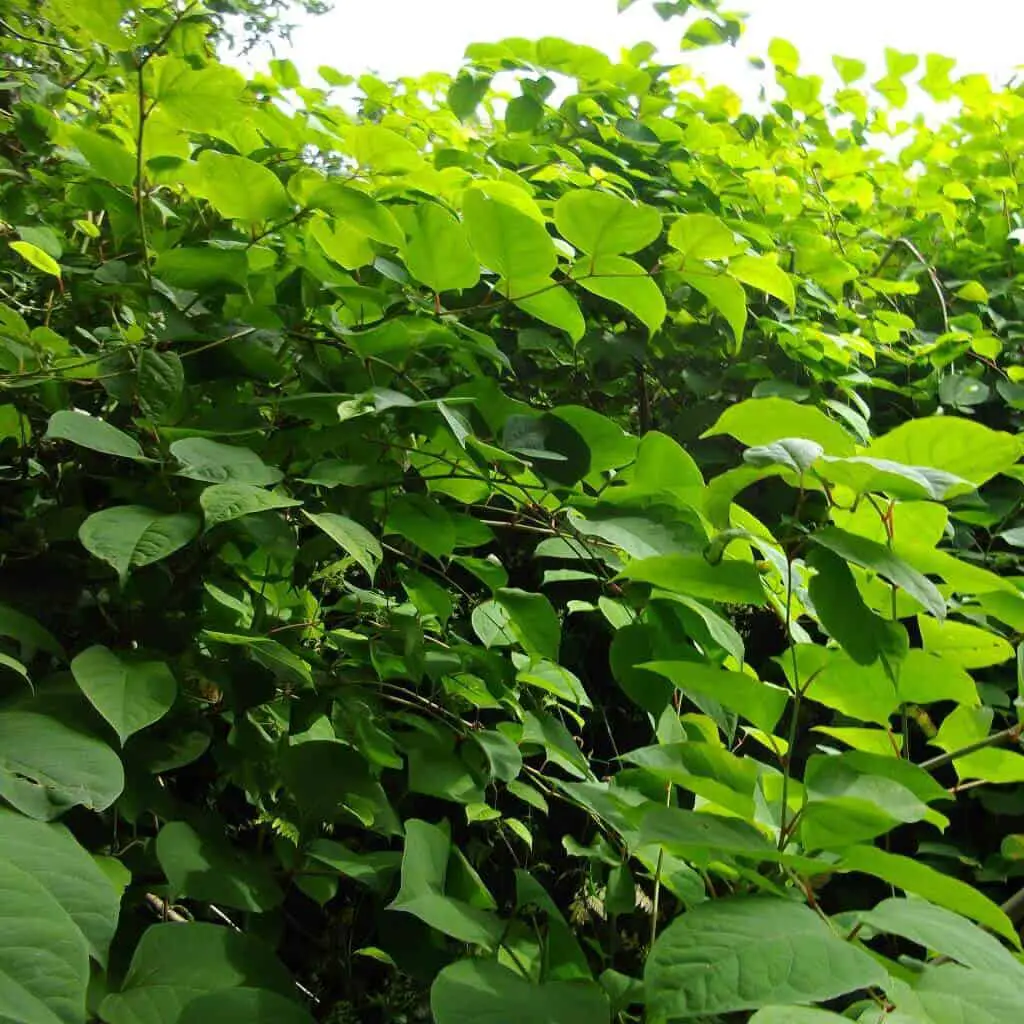
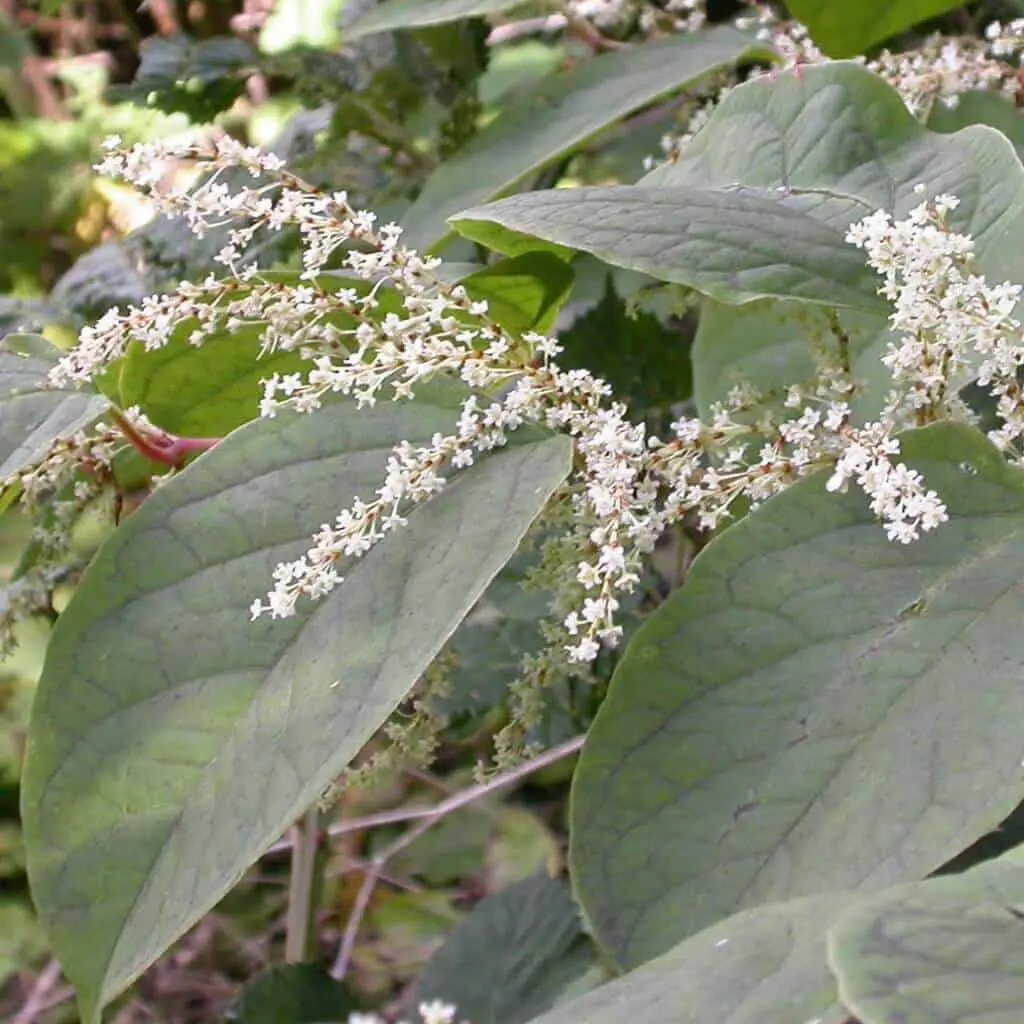
Knotweed is at its most stunning from May through September. The stems can grow to be more than 3 metres tall, providing a dense canopy of lush, green leaves.
The stems serve as temporary scaffolding for the chemical ‘factories’ in the leaves, which capture as much light as possible in order to power food production by fixing CO2 from the air into carbohydrates stored in the rhizomes.
As a result, unlike the permanent, solid stems of woody perennials, no energy is wasted in the production of hollow stems. On mature knotweed stands, the thicker stems can be up to 5cm in diameter. Knotweed stems have rings, or nodes, around them that give them the appearance of bamboo canes, but unlike bamboo, they can be snapped by hand.
The purple speckling on the stems also distinguishes them from bamboo. Another trait that aids in knotweed identification is the zig-zag pattern of alternate leaves and side stems, especially near the tops of the stems. The late flowering is the same way. There aren’t many plants that bloom profusely in September and form dense stands of 3m tall stems.
Key features of Japanese knotweed identification in Summer
- Knotweed stems are green with red/purple speckles and reach a maximum height of 2-3 metres.
They are devoid of substance. - They resemble bamboo because nodes between stem parts are plainly evident.
- Along the stems, the leaves make an alternative zig-zag pattern.
- The stems emerge from crowns that form dense bunches.
- Flowers bloom in the late summer (August/September).
Japanese knotweed in autumn
In Autumn the dense covering of leaves will remain, however, they start to turn yellow and wilt as we move into September and October. The knotweed plants are still about 2-3 metres tall and the hollow stems start to turn brown. See our images below to identify Japanese knotweed in Autumn.
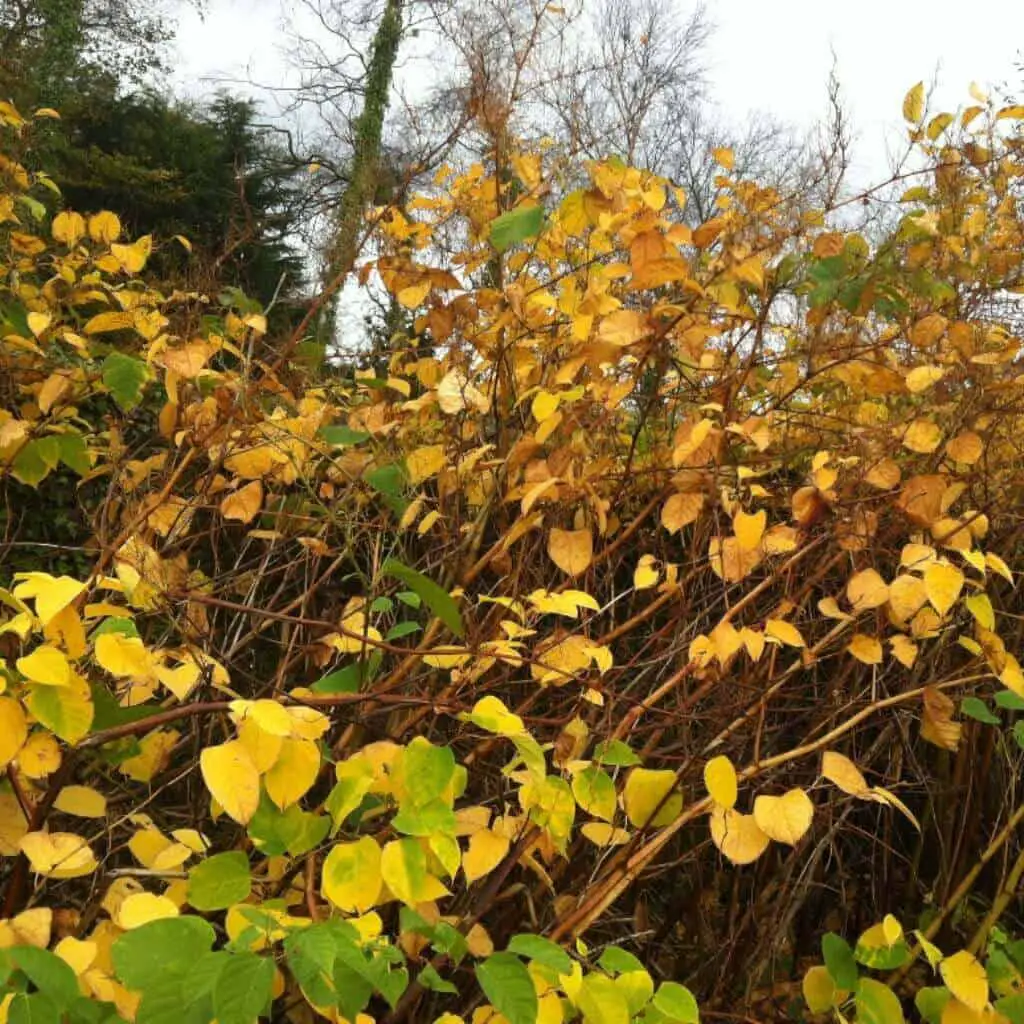
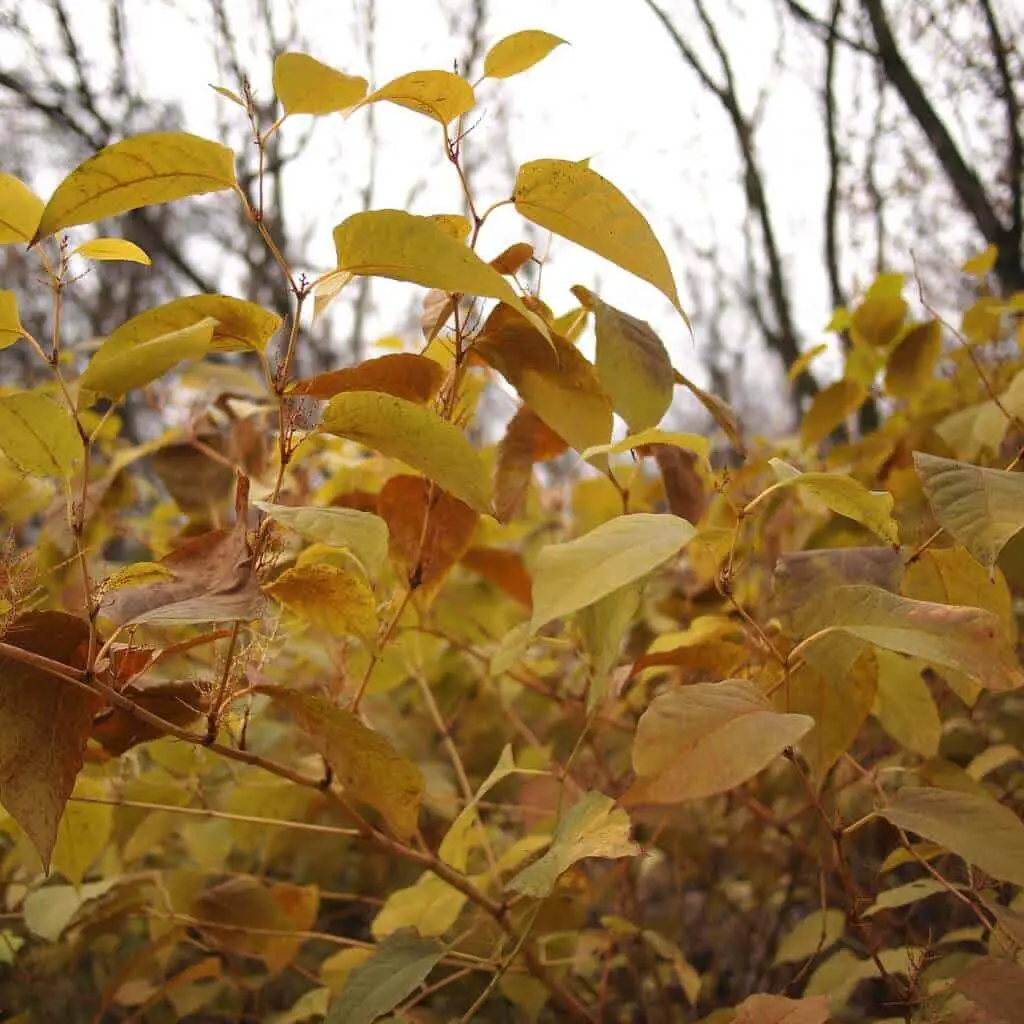
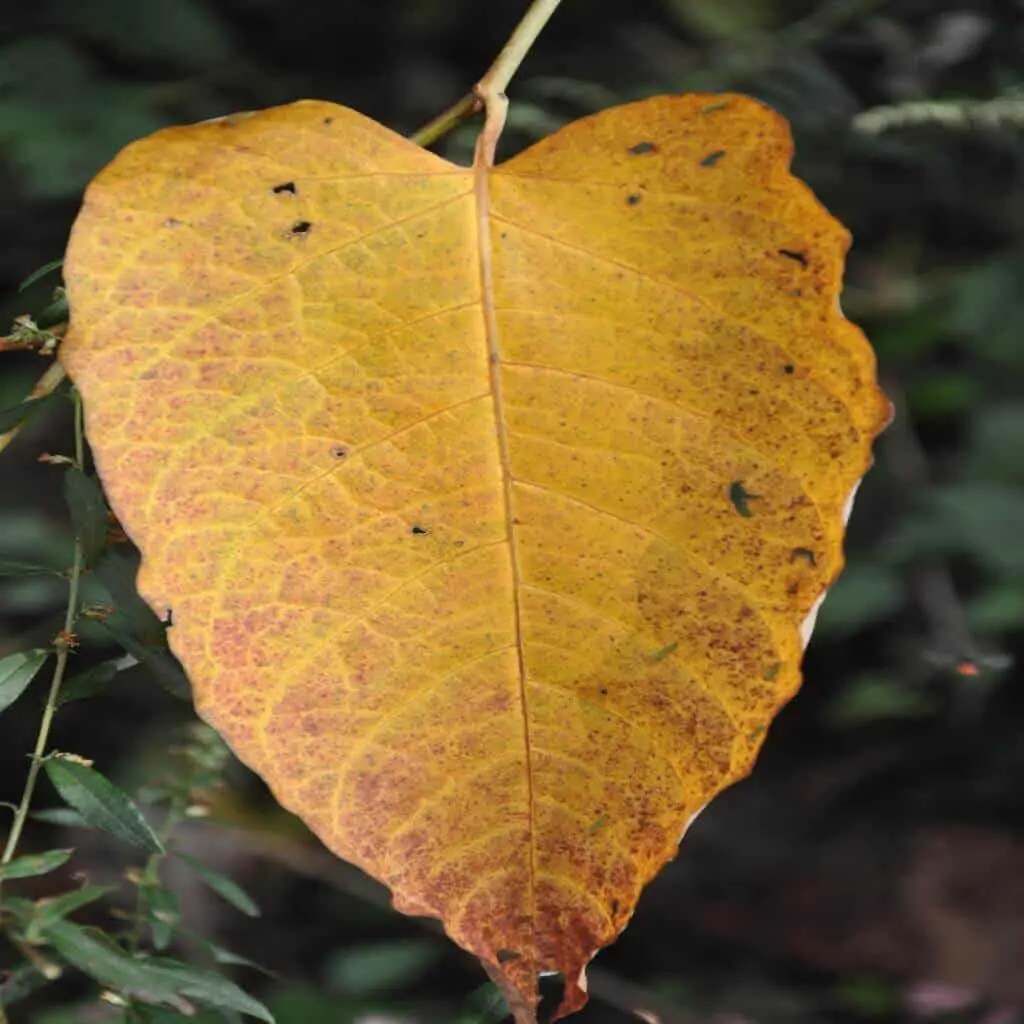
In early October, at the beginning of autumn, flowers are frequently still present. Because there are no male Japanese knotweed plants in the UK, some of these will have grown into seeds (achenes — from Russian vine pollen). The tiny white blooms and seeds are clustered in large panicles.
By the end of October, the flowers and seeds had been shed. Around this time, the leaves begin to turn yellow, then brown. Leaves can remain on some plants until December if there have been no frosts, especially if they are protected from the wind. The stems begin to wilt and die, turning a reddish-brown or straw colour.
Key features of Japanese knotweed identification in Autumn
- Stem bracts drop flowers and small (5mm) seed casings.
- Leaves that become yellow and fall off — yellowing can start at the leaf margins and extend outward.
- Stems turn red and drop their leaves.
Japanese knotweed in winter
During late autumn and the beginning of winter, the knotweed canes die off and the weed becomes dormant. The leaves turn yellow, then brown and fall off. The canes are hollow, dark brown and brittle and they collapse upon one another.
If the area hasn’t been treated, often the previous year’s decomposition can be seen underneath. See the images below to identify Japanese knotweed in winter.
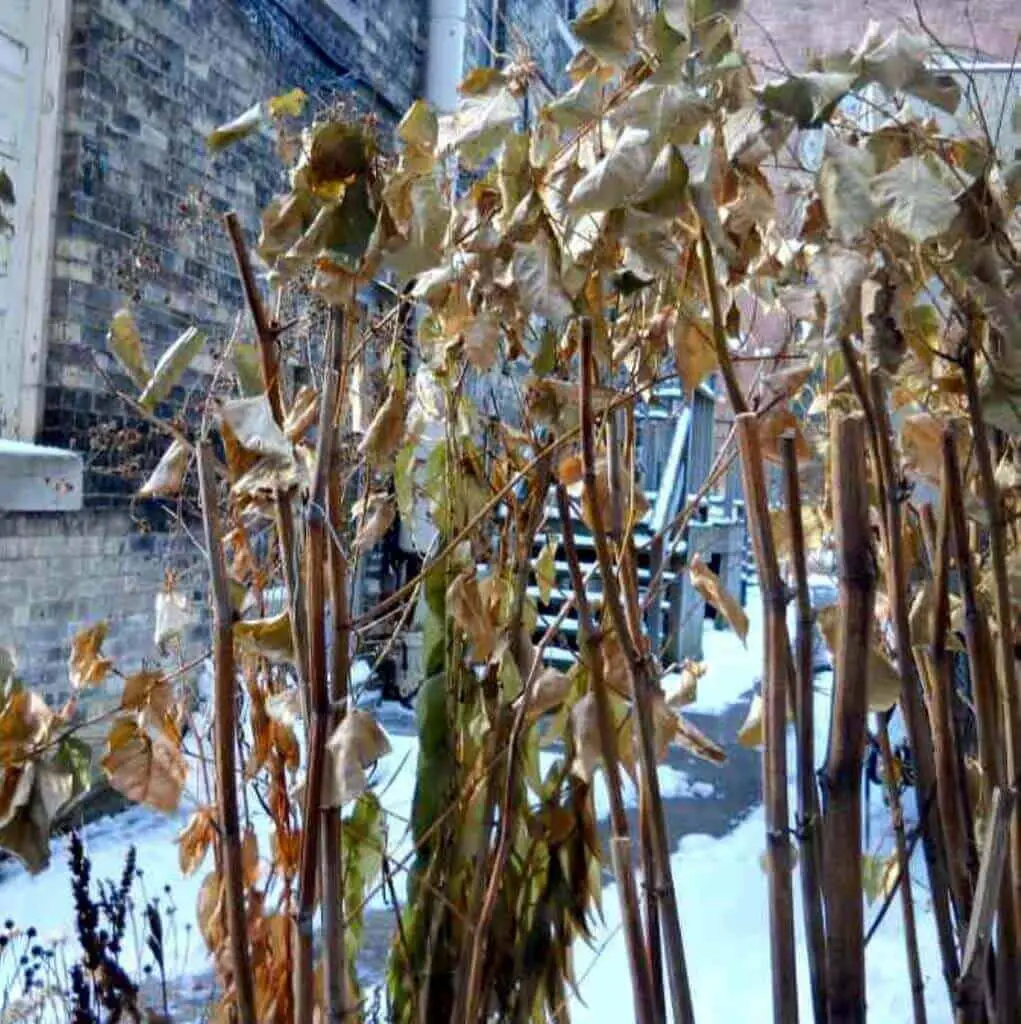
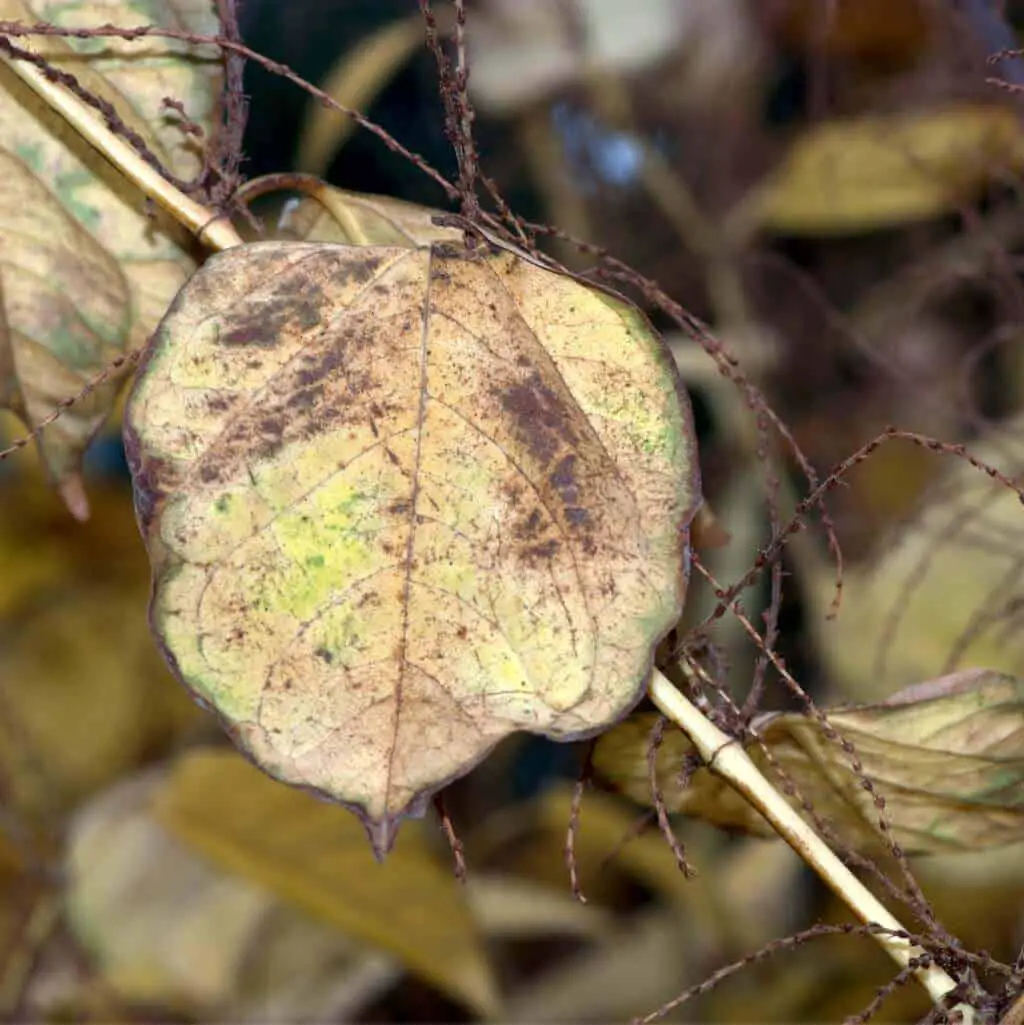
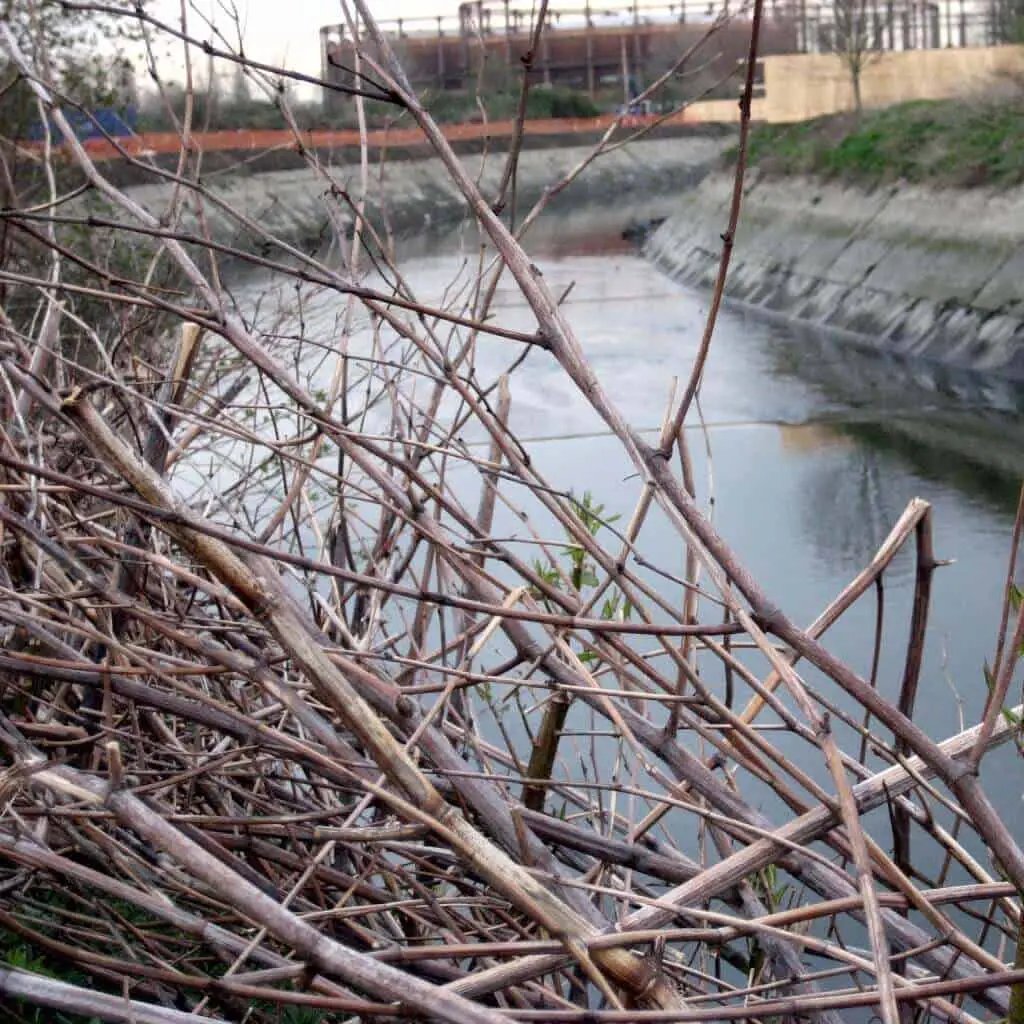
All that’s left when the leaves have dropped are the lifeless stalks, which can last for years. However, because they are delicate and brittle, they are frequently toppled by the weather or pushed over as new stems sprout in the spring.
Knotweed stems, particularly where they appear as dense stands, might be easier to identify in the winter since most other non-woody vegetation dies back.
Some knotweed stems are seen in a generally healthy, green form as late as February, especially in mild winters and in regions where plants are covered from the weather.
Key features of Japanese knotweed identification in Winter
- The leaves fall off and the shoots die back, leaving behind dead, straw-coloured, hollow stalks that resemble bamboo stems.
- Some knotweed branches might persist, or new shoots can sprout, during the winter months after moderate autumn with no frosts.
Persistence and Spread
Japanese Knotweed (Fallopia japonica) is an invasive species that has been causing problems around the world since it was first introduced in 1825. It is a fast-growing perennial plant which can spread quickly, smothering other plants and damaging buildings, roads and other infrastructure.
In addition to its physical damage, Japanese Knotweed also has serious economic impacts as it can reduce property values and make land unusable for development or agriculture. As such, it poses a significant threat to biodiversity and ecosystems across large areas of the globe.
The sheer scale of this problem means that controlling Japanese Knotweed requires a concerted effort from both governments and private citizens alike.
Japanese Knotweed is native to Japan and other parts of eastern Asia but was introduced to North America and Europe in the late 19th century. In North America, this species has spread rapidly from Nova Scotia down into New England, throughout much of the Midwest, as well as western Canadian provinces such as Saskatchewan.
It is believed that this species was introduced to North America as an ornamental plant, but it has since become a major problem due to its ability to rapidly outcompete native species.
For example, Japanese Knotweed can grow up to 8 feet per year and can form dense mats which smother other plants. In addition, its shallow roots can damage infrastructures such as buildings, roads, and agricultural systems.
While Japanese Knotweed has been a problem in North America for many years, it has become an even bigger issue in Europe over the past few decades as this species continues to spread across several countries. In the United Kingdom, for example, Japanese Knotweed is considered to be one of the worst invasive species due to its proliferation throughout the country.
This species has been able to spread rapidly due to its ability to thrive in a wide range of habitats, including forests, roadsides, and riverbanks. In addition to damaging plants and infrastructure, Japanese Knotweed also reduces property values by up to 50% when it invades an area. As such, controlling this species is a major issue in many European countries.
Growth and Reproduction
Japanese Knotweed (Fallopia japonica) is a fast-growing, invasive species of plant native to East Asia. It can grow up to 10 feet tall and form dense stands that outcompete native vegetation. Its root system can reach depths of up to 9 feet, making it difficult to eradicate once established.
Japanese Knotweed reproduces both sexually and vegetatively through rhizomes or underground stems. Rhizomes are capable of sending out shoots up to 7 meters away from the parent plant within one season, allowing it to rapidly spread and colonize new areas.
The plant also produces seeds that are dispersed by wind and water currents, further aiding in its dispersal across landscapes.
Management and Control
Japanese knotweed is an invasive species that can cause serious damage to the environment and to infrastructure if left unchecked. It has become a major problem in many parts of the world, including the United Kingdom. In order to keep Japanese knotweed from spreading and causing further destruction, it is important for property owners, homeowners, and gardeners alike to understand how to manage this plant.
This includes both prevention measures as well as cultural control techniques such as mowing or cutting back Japanese knotweed plants before they spread too far. With proper management strategies in place, we can prevent Japanese knotweed from doing any more harm than it already has done.
Japanese knotweed is a highly invasive plant that can cause substantial environmental damage if left unmanaged. It is vital for homeowners and property owners to learn how to manage this plant successfully, which includes both prevention and cultural control measures such as mowing or clipping back the invasive plants before they spread too far.
We can assist and prevent future destruction to your property from this invasive species and help keep our environment healthy by using effective management measures.
The Legal Situation
Japanese knotweed is a highly invasive plant that can cause significant damage to buildings, roads, and infrastructure. Because of its destructive nature, it has been classified as an “invasive non-native species” under the Wildlife and Countryside Act 1981 in England and Wales.
This means that it is illegal to plant or allow Japanese knotweed to spread in the wild, and home and property owners are legally responsible for taking steps to control or eradicate it.
In addition to legal obligations, there are also legal implications for those buying or selling a property that is affected by Japanese knotweed.
For example, if you are planning to buy a house with an existing infestation of this weed, you may want to include a clause in the sales contract specifying that the seller is responsible for paying for its treatment and removal.
Additionally, if you are selling your property and know it has a Japanese knotweed infestation, you will need to make sure that any potential buyers are aware of this issue so they can take steps to address it before purchasing the home.
If you are dealing with Japanese knotweed on your property, it is important to seek professional advice and guidance regarding the best course of action. There are a number of effective treatment methods available, such as chemical control or digging out the roots, but it is crucial that the right steps are taken to prevent further spread or damage.
Japanese Knotweed Treatment and Removal
It is critical to become acquainted with the specific action plan that has been adopted. This will help save time and resources when it comes to dealing with the weed plant. More importantly, when chemicals are involved, it is critical to understand how the chemicals operate, how to apply them to the weed plant, how long to apply the chemicals, and, most critically, what precautionary steps to take to preserve the environment.
You must assess the manpower and capital resources available to successfully remove Japanese knotweed, depending on the scale of the infestation. This is because eliminating this invasive weed should not be half-hearted work that is done every now and then, but rather a job that requires all hands on deck and consistency until the weed plant is completely eradicated.
Below is a list of some of the most successful methods of removing Japanese knotweed. Start with the least expensive through to the most costly method to achieve your end goal of removing the weed from your property.
- Use of herbicides
- Cutting it down
- Digging it out
- Excavation
- Burning it
- Burying it
- Barrier protection
- Disposing of it
- Engaging a professional contractor
Which of these nine methods you employ will depend on the size of the infestation, timescale and budget.
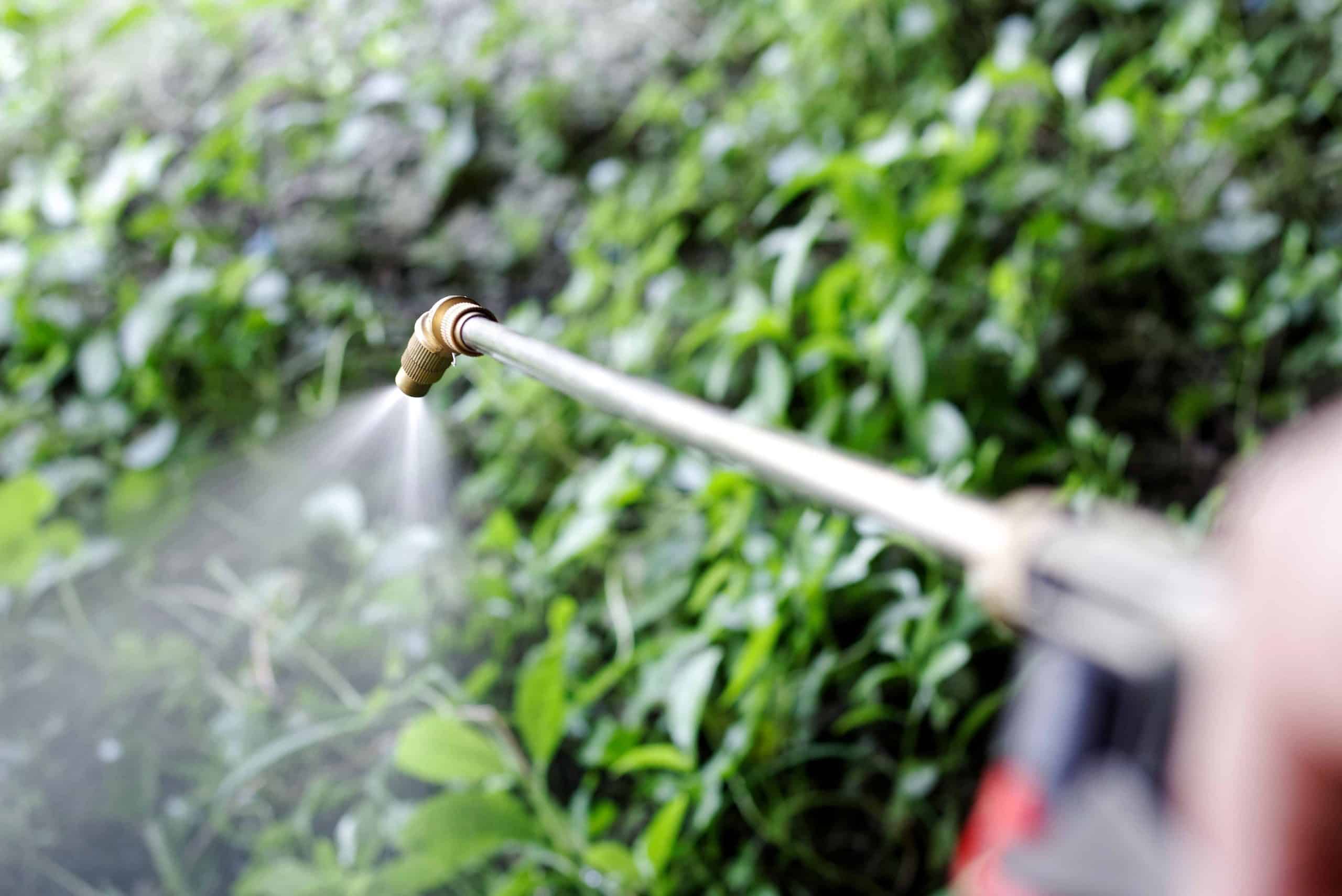
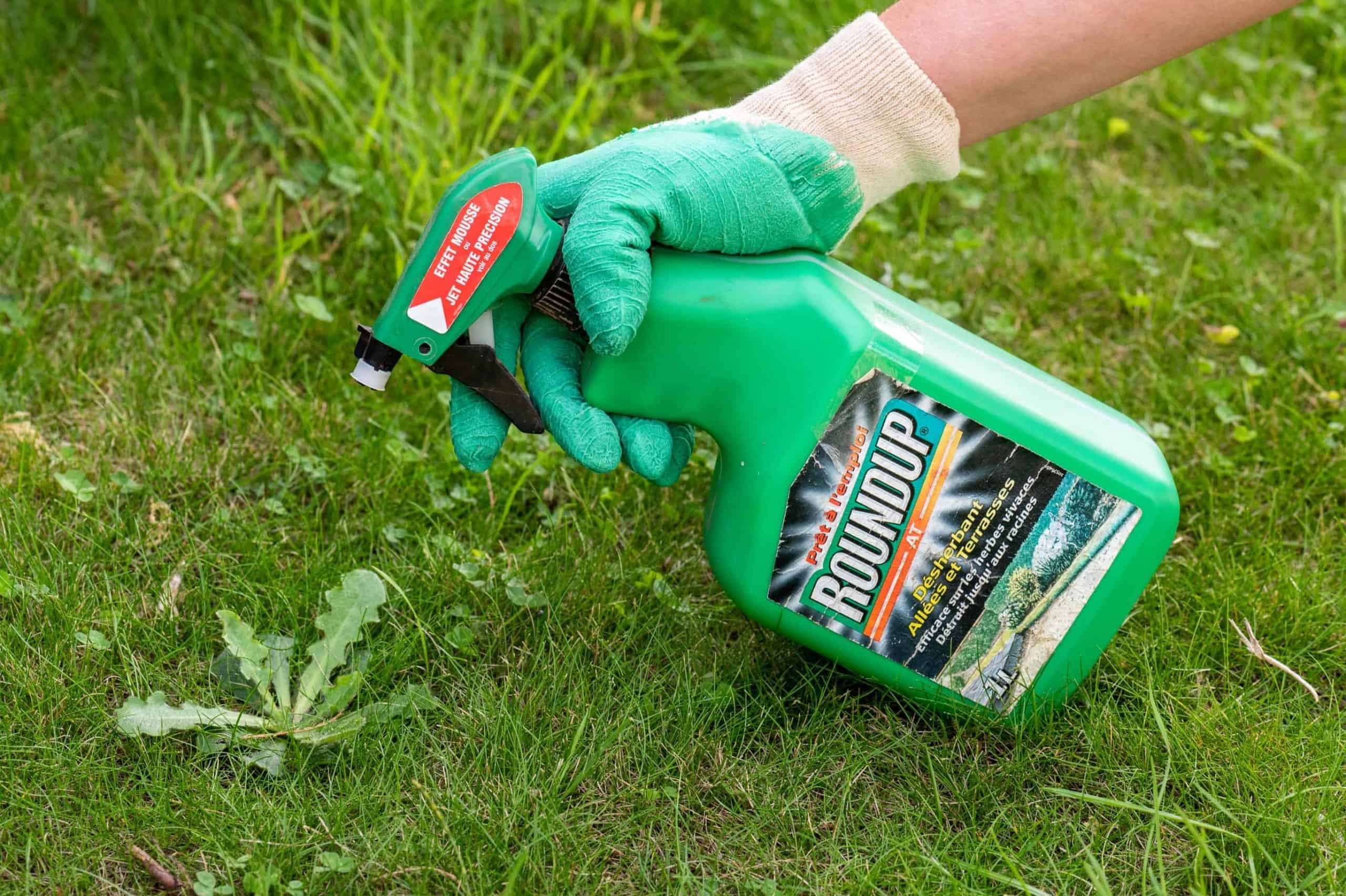
1. Using Herbicides
Glyphosate-based herbicides are the most effective chemicals for combating Japanese knotweed. To have the best access to the plant, trim the old stems before using them.
Herbicides are chemical ingredients that are made industrially to combat various weeds in their various forms. Roundup Tree Stump and Glyphosate herbicides for Japanese knotweed have been tested, tried, and confirmed to function with effective results.
Herbicides can be quite harmful to the environment because of the high chemical compounds in them; therefore, while using them, it is imperative that one is familiar with the technique for applying them to weed plants.
Chemicals are effective if sprayed directly on the weed plant or if a liquid is injected directly into the weed plant’s stems to allow for a breakdown from the inside out. Always read the instructions handbook of each chemical before using it as a preventive step.
Spray the weed while flowering in the summer and before it dies in the autumn. Repeat the treatment until the weed is entirely gone. Using this herbicide, eradicating knotweed will take roughly six seasons or at least two years.
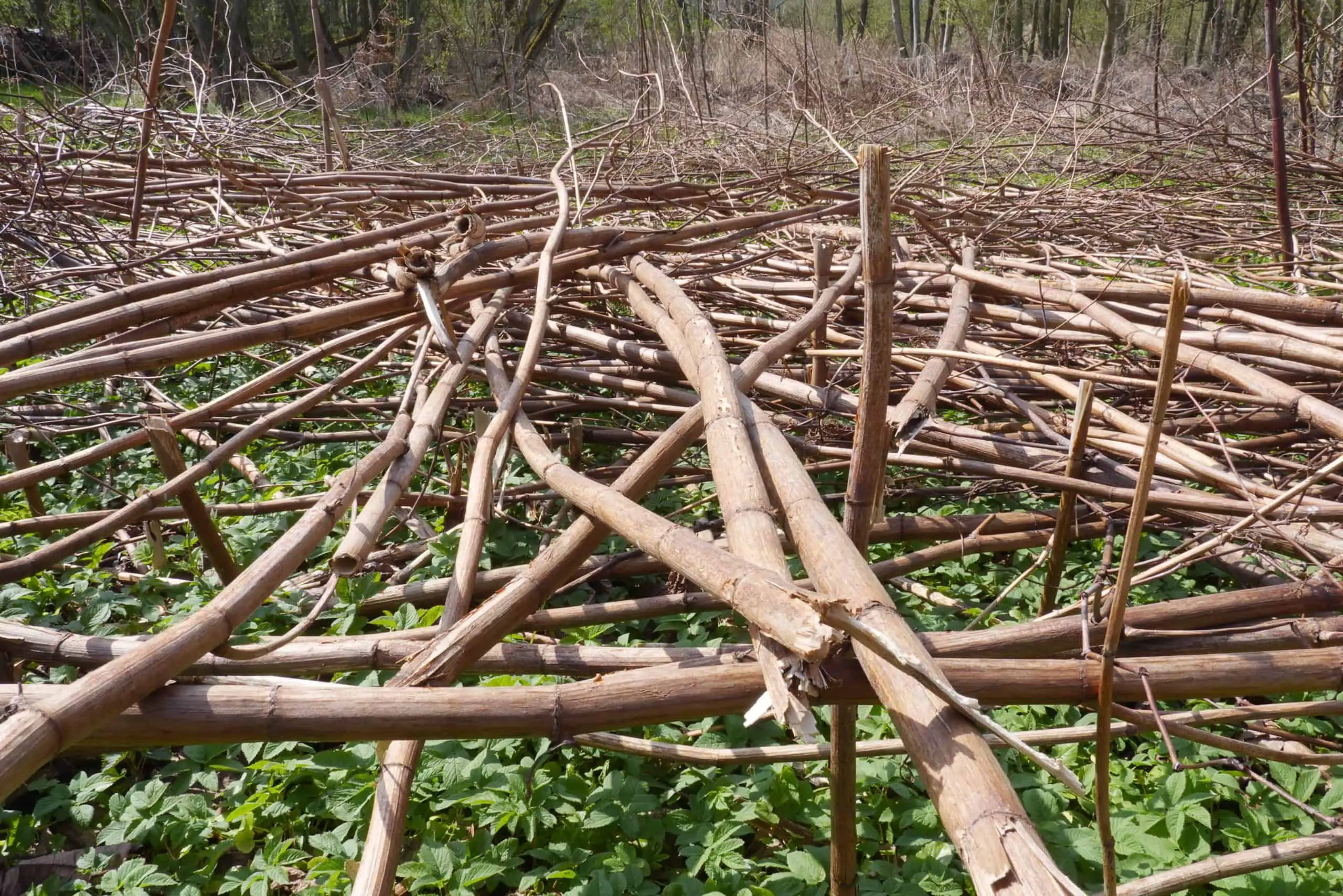
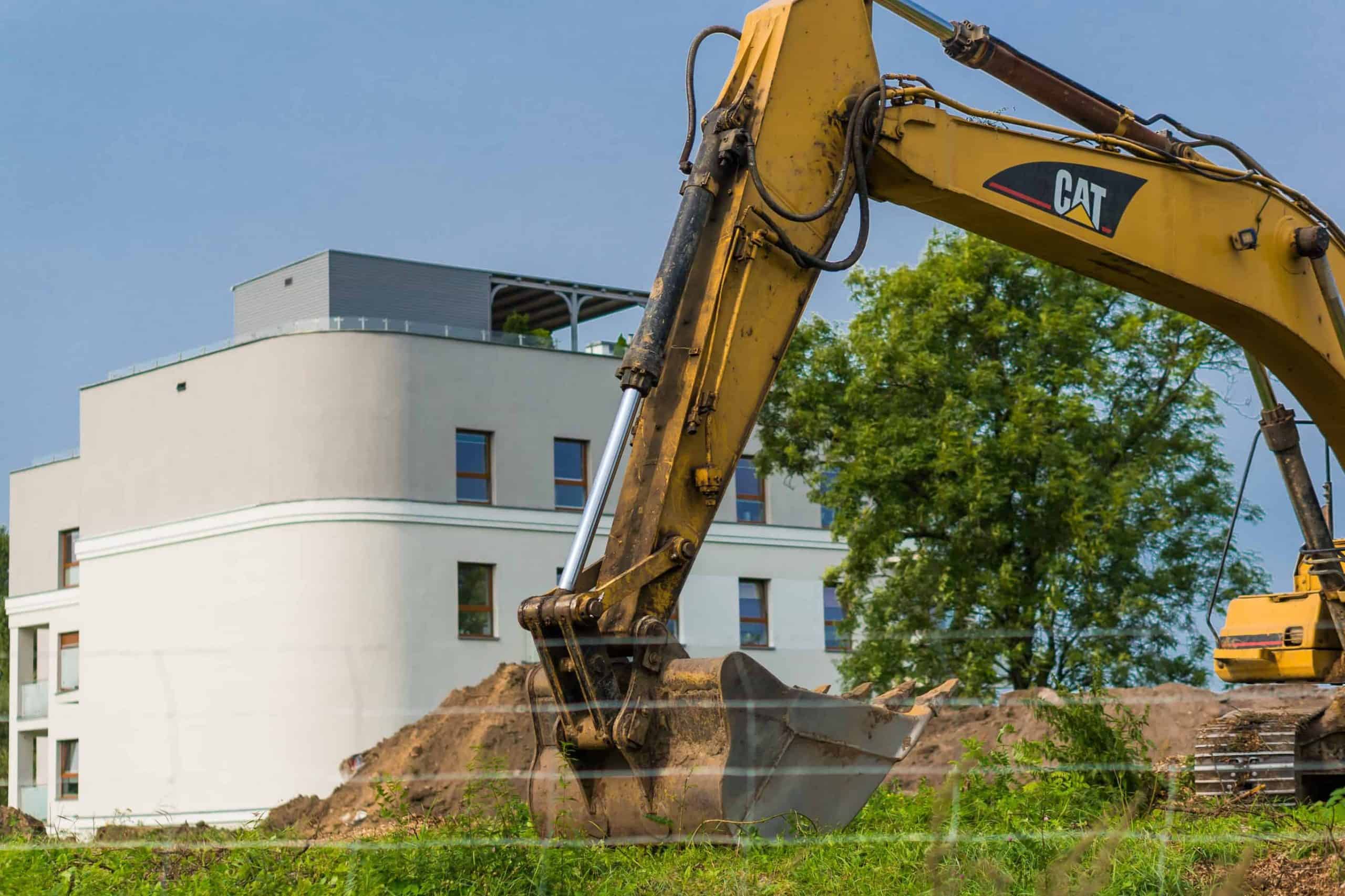
2. Cutting it Down
Techniques like cutting the Japanese knotweed stems as close to the soil surface are feasible and then removing the cut pieces. The waste material that has been chopped can either be completely burned or buried for disposal.
Ensure that the item is burned and exposed to extremely high temperatures, preferably in an incinerator, to ensure that no fragments survive the process. Both methods are effective, but the most essential thing to remember is that disposal should always take place at an approved facility with the necessary permits.
Any Japanese knotweed trash should never be left unattended because the weed may easily re-grow even from cut rhizomes, making it a ticking time bomb.
3. Digging it Out
After cutting the weed plant’s stems successfully, the next step is to dig out the weed’s root system. If the weed plant is still young, you can dig it out by plucking out the roots; however, if the weed plant has matured, you may need to hire excavators to do the dirty work for you.
You can manually dig up knotweed, but do so at your own risk. The plant’s vast root structure makes eradication difficult, and regeneration is always possible.
Dig up as much of the root as possible to prevent the regrowth of the condition. It will take months to years to completely remove the plant by digging it up. Seek the advice of a qualified and experienced professional contractor to ascertain the treatment plan timescale.
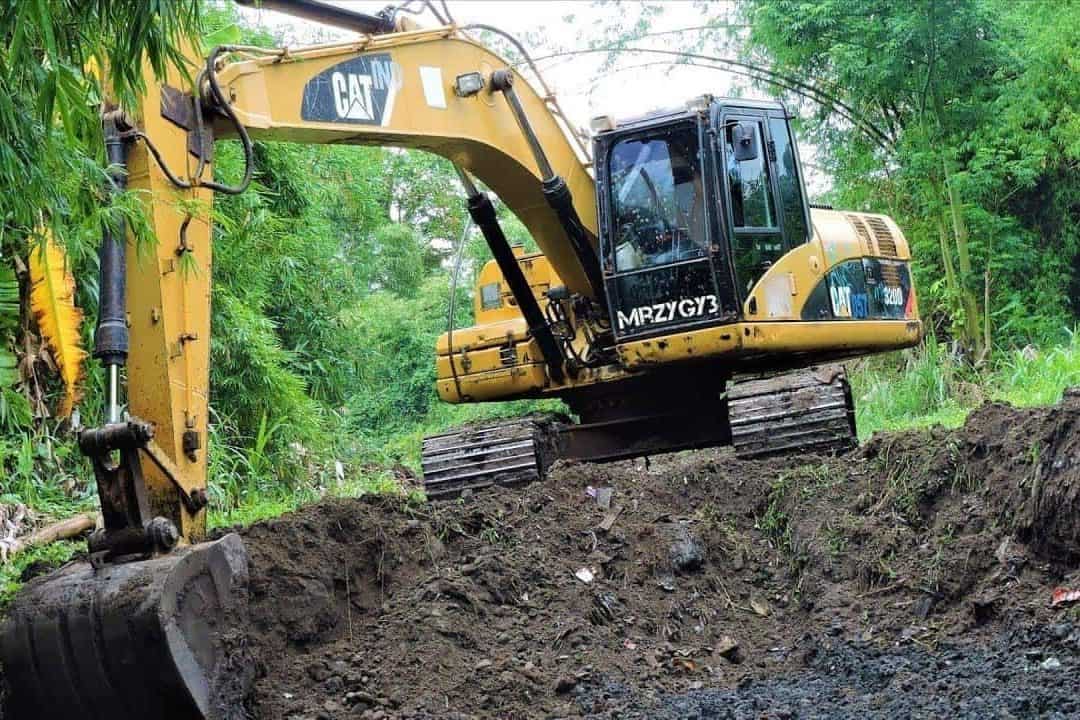

4. Excavation
This method primarily entails using excavators to excavate the Japanese knotweed and its root system, as well as digging up the afflicted soil and transporting it to a landfill zone that specialises in the disposal of undesired material.
This is an extreme measure and requires trained professionals to undertake this work. Being both costly and intrusive is normally a preferred option when the infestation of this weed is on a large scale.
5. Burning it
Controlled burning is the most effective and safest method of eliminating Japanese Knotweed. Private homeowners can burn Japanese knotweed debris in their gardens under controlled conditions.
It is possible to burn Japanese knotweed waste on your property after it has dried out, although Japanese knotweed rhizomes may survive the procedure.
You cannot, however, transport the rubbish to another location to be burned or take the burned rubbish to your council’s conventional landfill or recycling centre since cross-contamination will occur. It will require the services of a licensed professional as well as permission to transport it to a specialised landfill site for disposal.
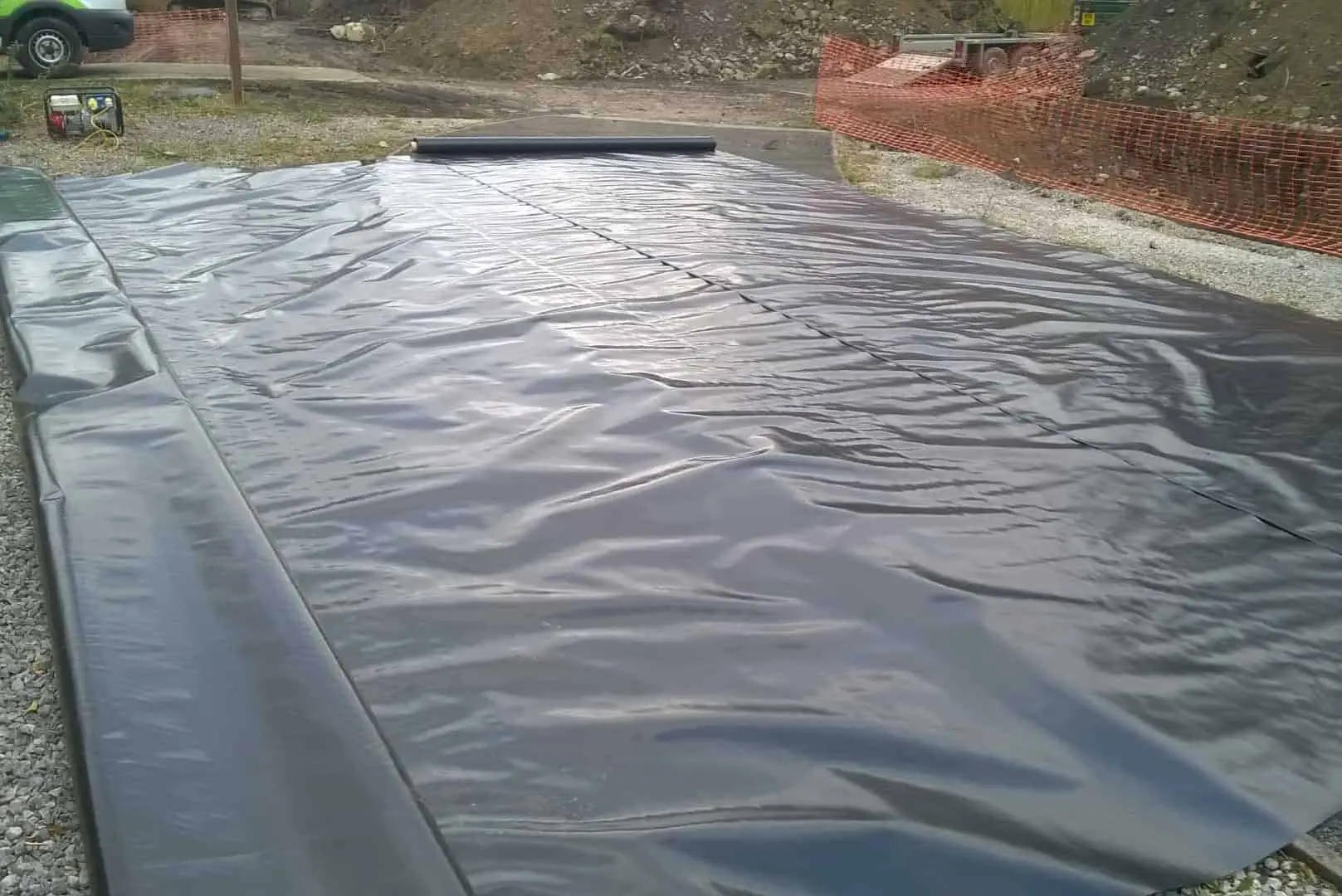
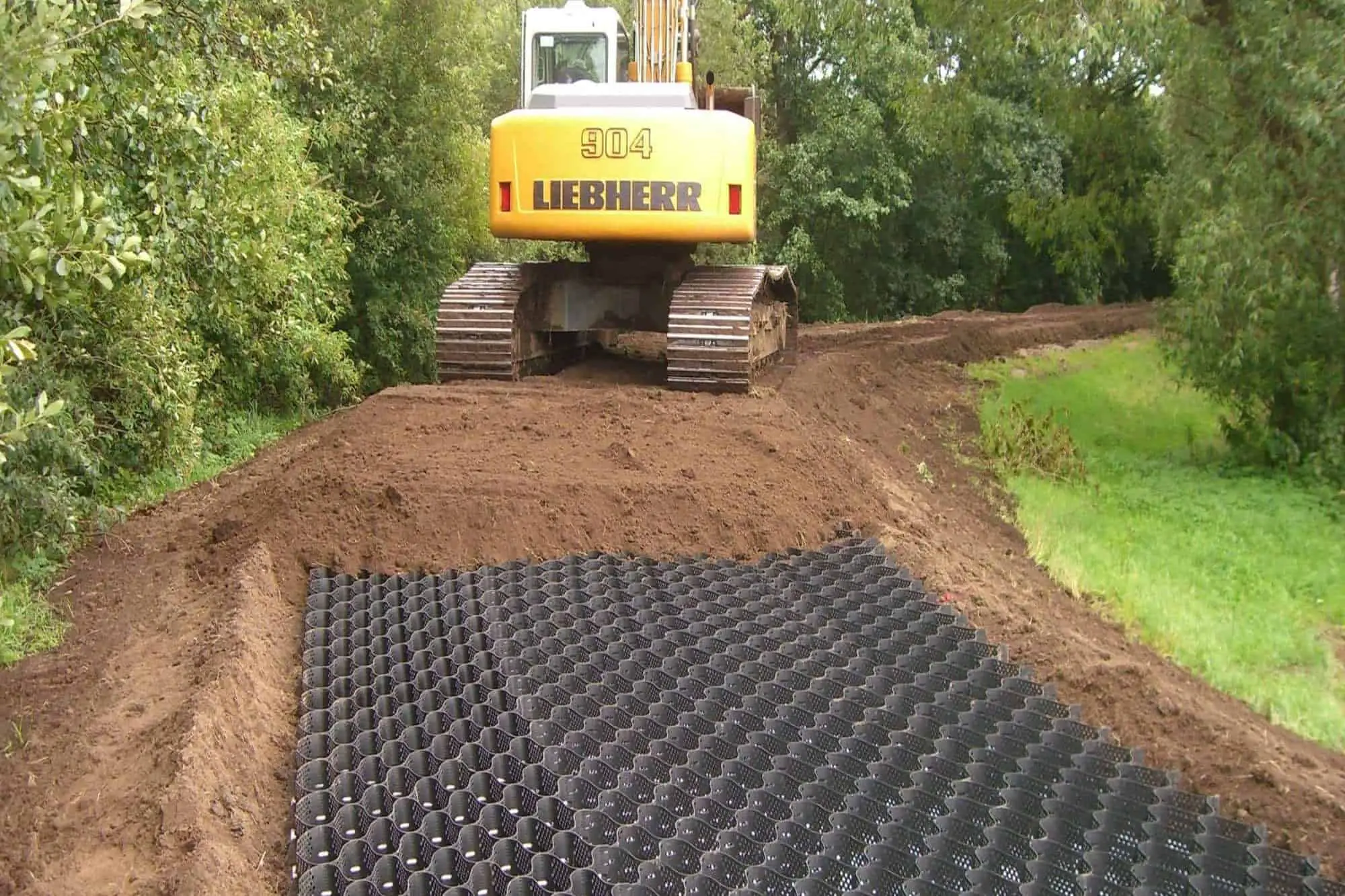
6. Burying it
Burying, on the other hand, entails putting the chopped waste of the Japanese knotweed into impermeable containers or materials and disposing of the waste by burying it in a location that has been approved for such purposes.
The only thing to keep in mind when burying weed plant debris is that no other waste material, especially organic in nature, should be buried with it, as this could lead to a new infestation in a different location.
7. Barrier Protection
It is possible to slow knotweed’s growth by using chemical techniques such as weed suppressor textiles. The landscaping materials are spread over the removed soil, effectively stopping the renewal of old weeds and preventing the emergence of new ones.
Impenetrable coverings are frequently employed to eradicate Japanese knotweed infestations. Denying the weed plant sunshine and moisture stunts its growth and aids in its eradication, however, this is a long process that may require patience.
The key to making coverings work is to cover the top half of the soil to prevent sunlight from reaching it, as well as the perimeter of the area to prevent rhizomes from escaping through the sides and causing new growth.
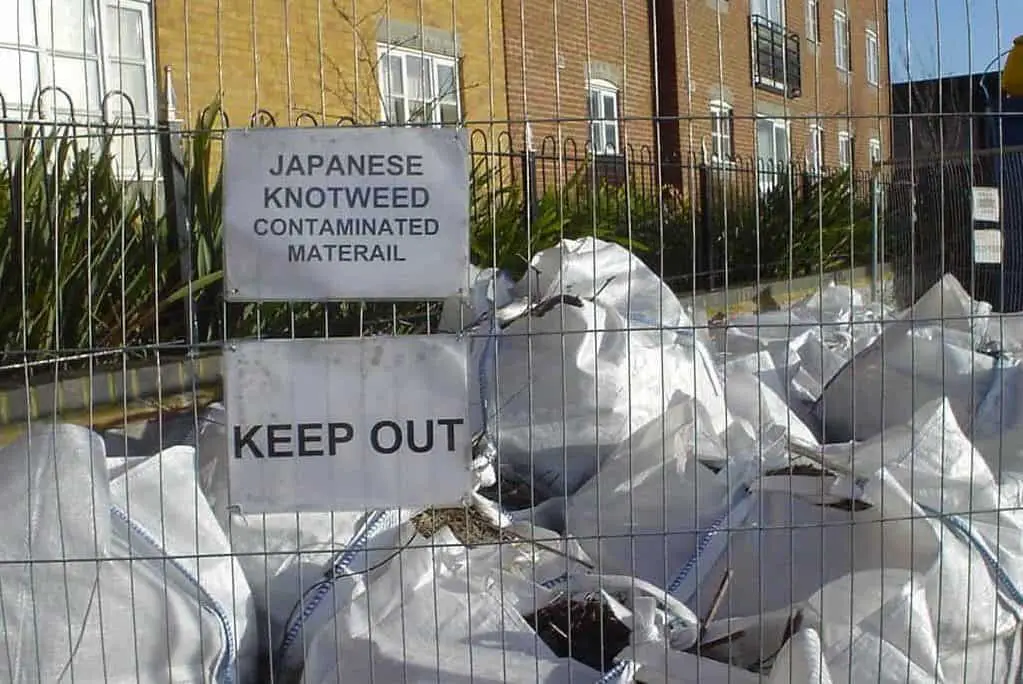
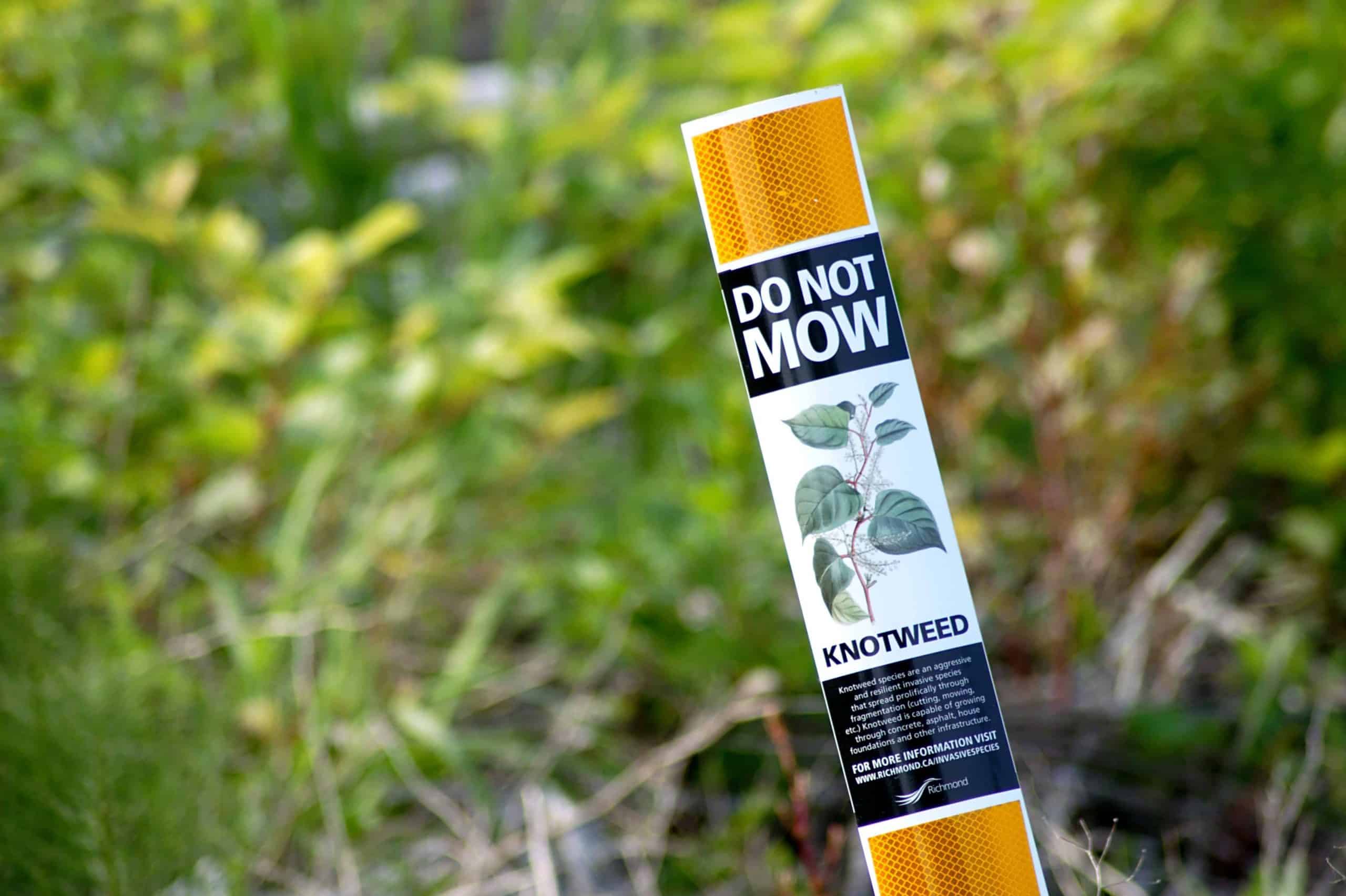
8. Disposing of it
Avoid spreading contaminated soil. Weeds develop in contaminated soil from minute fragments. You should dispose of the material at licensed disposal sites to avoid pollution. You should also avoid disposing of the weed killer with your green waste.
Using a registered professional would be advised as they will have the suitable training to remove the Japanese knotweed waste safely and securely.
9. Engaging Professional Help
If the knotweed is too stubborn to get rid of, it is advised to seek help from an expert. Seeking professional advice is pricey, but then it can be the only option you have.
Not all types of Japanese knotweed infestations can be treated using home remedies. Certain infestations, particularly those in commercial locations or protected regions like national parks, necessitate the assistance of experts in their removal.
There are a lot of companies that offer to get rid of Japanese knotweed.
Japanese knotweed is non-native perennial knotweed that is subject to government regulation because of its rapid growth and ability to choke out other plants in its path.
If you’ve discovered Japanese knotweed in your garden and want to get rid of it, hiring a professional in Japanese knotweed removal will ensure that the job is done effectively and in accordance with a treatment plan that won’t harm your other plants.
Specialists have access to better weed killers and skills on how to speed up the eradication process.
If you want to sell your house, don’t try to get rid of the weed yourself; instead, engage a weed expert to start treatments on your property. If you have Japanese knotweed, mortgage lenders will require professional confirmation.
Herbicide effects on Japanese knotweed
Japanese knotweed will begin to die after being doused with herbicide. The leaves will begin to brown and wilt, and the plant will die back to the ground. It is crucial to remember, however, that herbicides do not kill the plant’s roots, so if they are not removed, Japanese knotweed may recover.
Before taking any effort to eradicate Japanese knotweed from your home, you should speak with a specialist. They will be able to advise you on the best course of action for your specific case and assist you in securely and successfully removing the plant.
- Japanese knotweed herbicide treatment can have a variety of consequences on stem growth.
- Glyphosate-containing herbicides (e.g., Roundup) can generate ‘Bonsai’ growth, which is distinguished by short clumps of growth with tiny leaves.
- Herbicides containing synthetic auxins, such as aminopyralid, can cause significant stem twisting.
In Conclusion
This is by far, the hardest weed to remove from your garden. Built for our climate and resilient to albeit the most persistent and aggressive treatment plan. Only with perseverance and knowledge will you overcome it and ensure you retain not only the value of your property, but also avoid its unsightliness and potential damage to your property.
Knotweed Removal aims to provide the most up-to-date information, help and advice for YOU to make informed decisions. If you are unsure or uncertain about how to proceed, please reach out to us and we will gladly come back and advise you as best we can.
Governmental advice can be found here and the UK law covering the removal of Japanese Knotweed as stated under the Wildlife and Countryside Act 1981 can be found here.
The best means to contact us is via our email – hello@knotweedremoval.tips
Do not forget we have a library of blogs covering many areas relevant to Japanese Knotweed, our free downloadable How-to Guides and Product Reviews on the latest methods being employed to eradicate or remove Japanese Knotweed.
Knotweed Removal, UK

